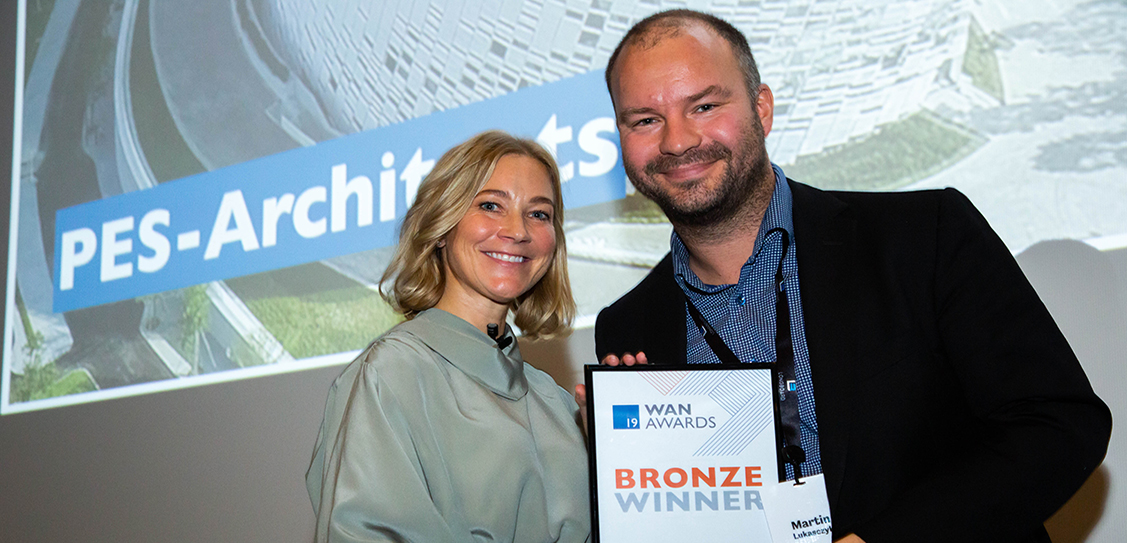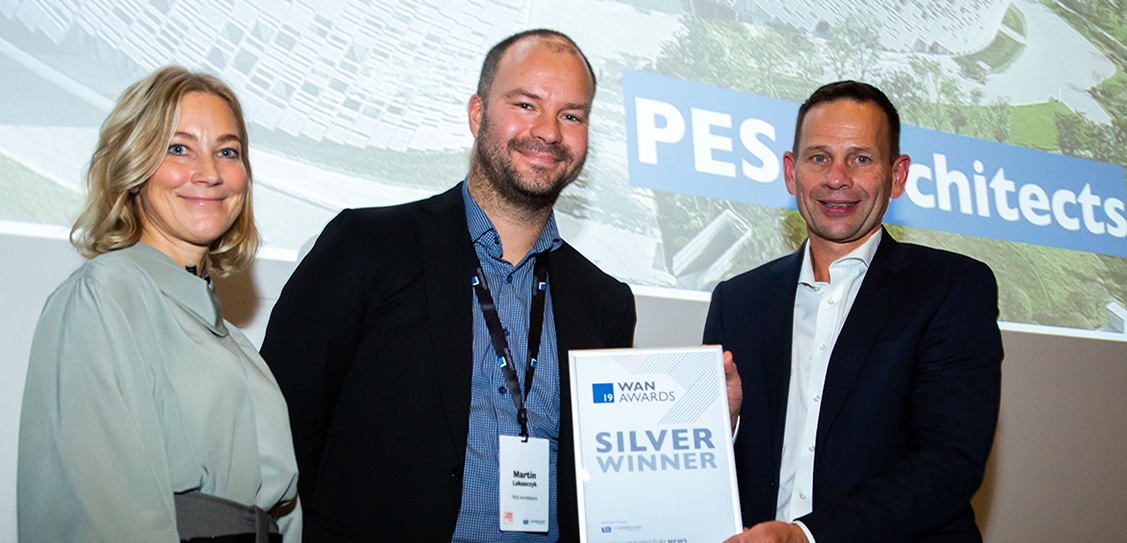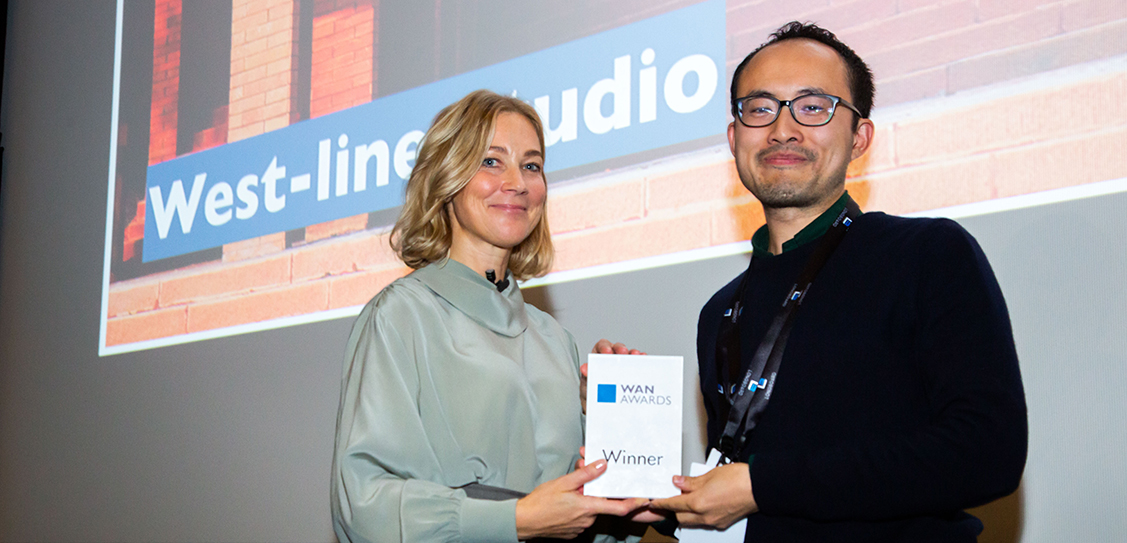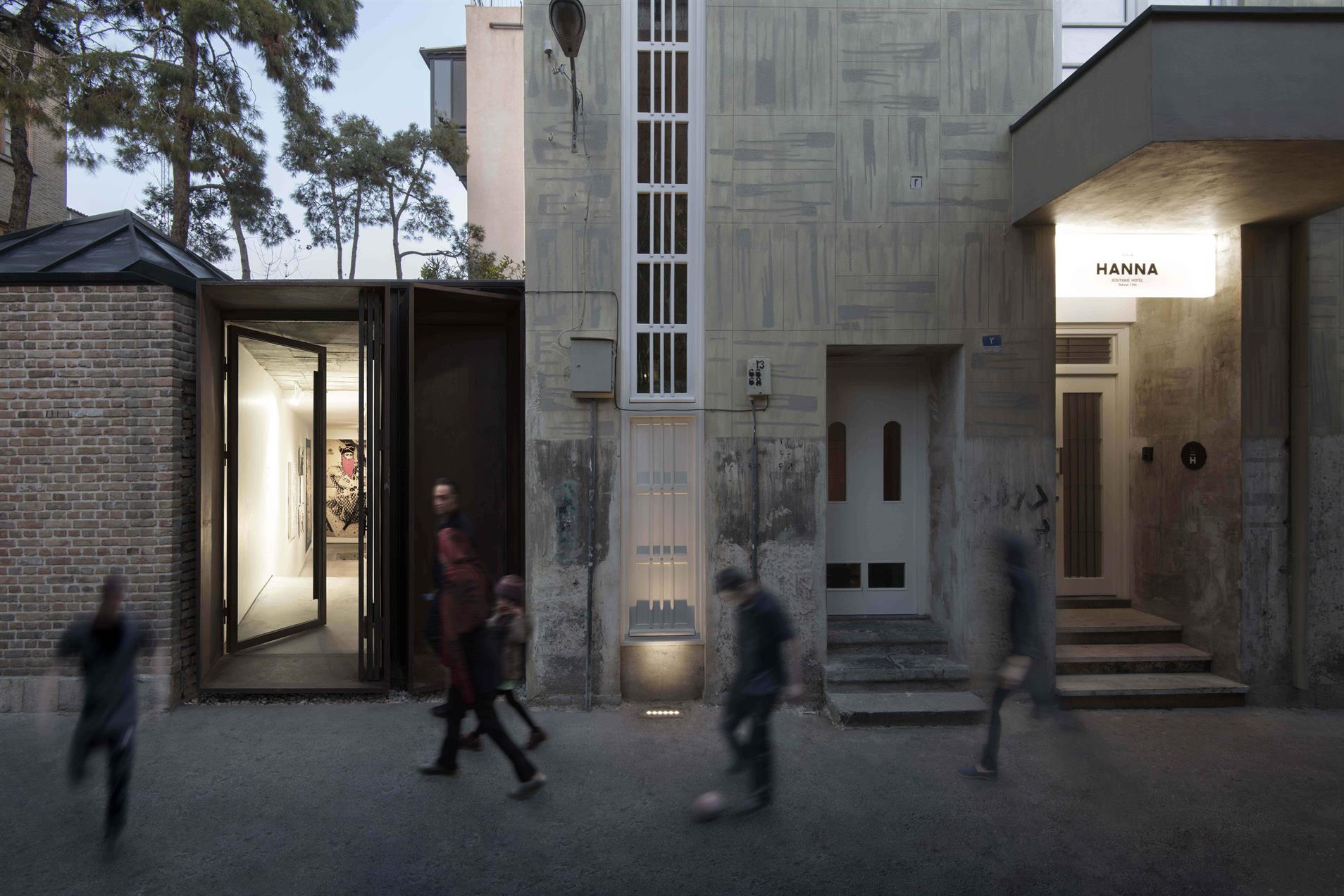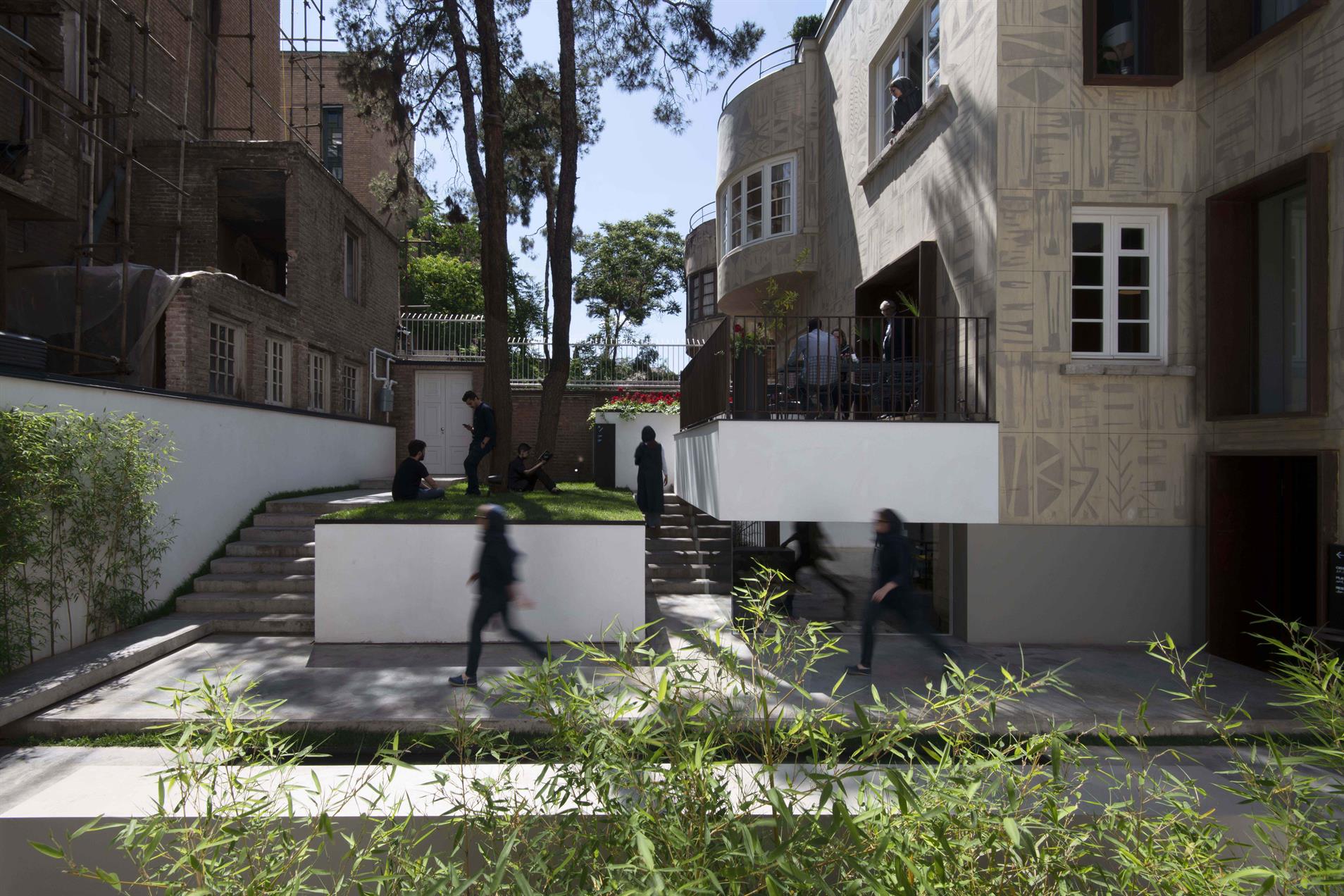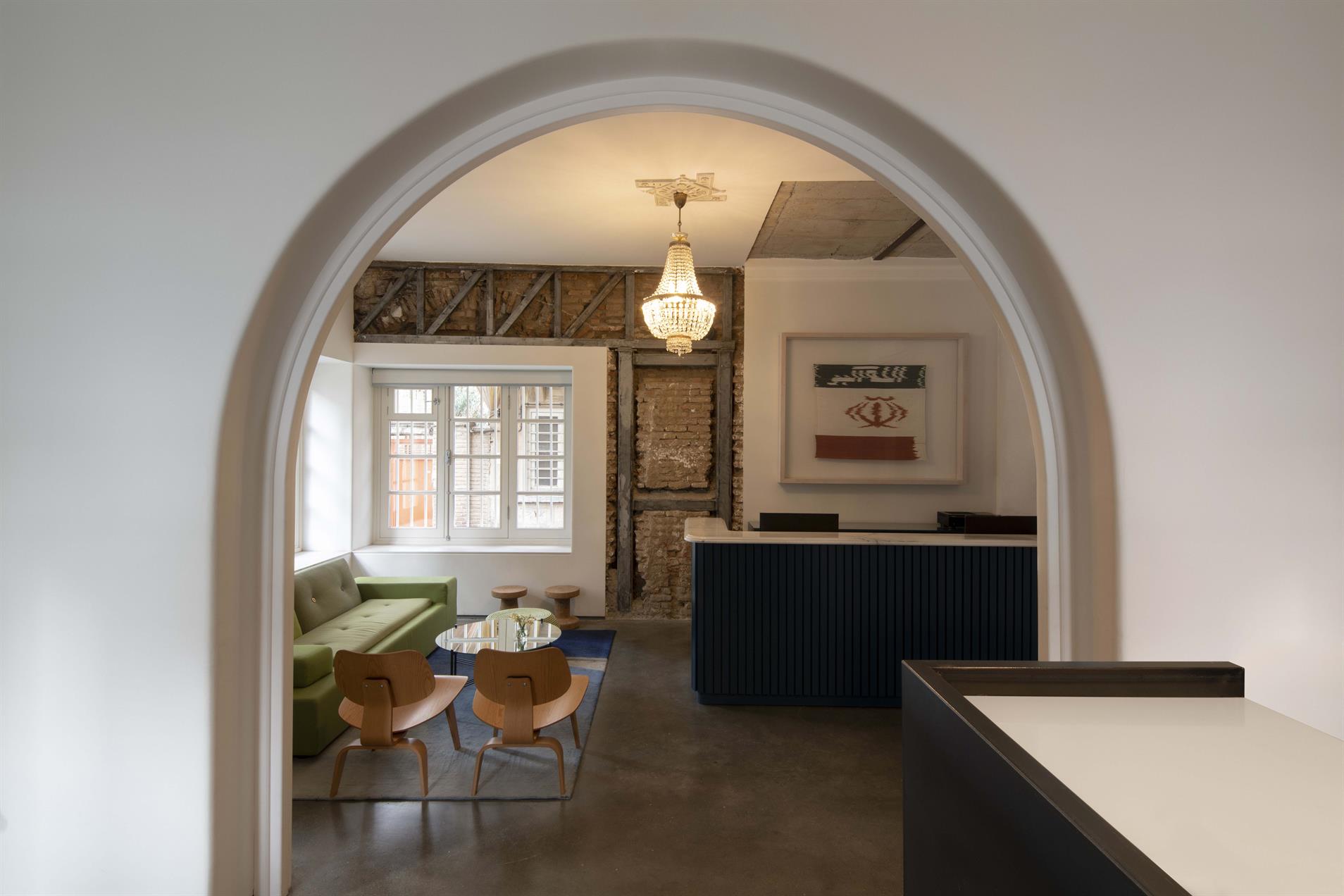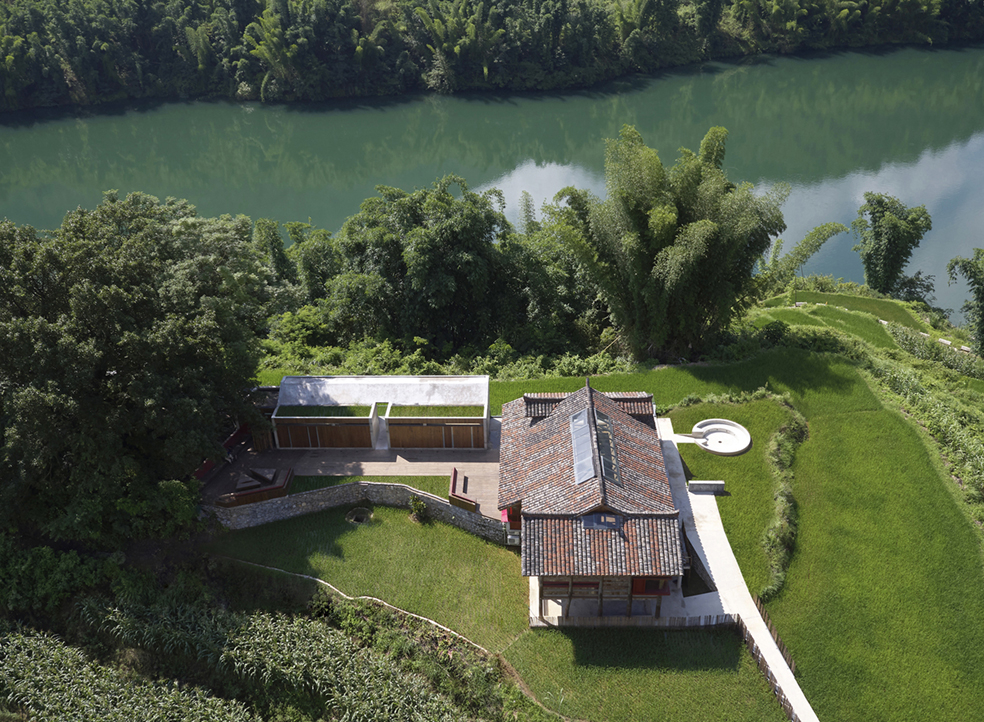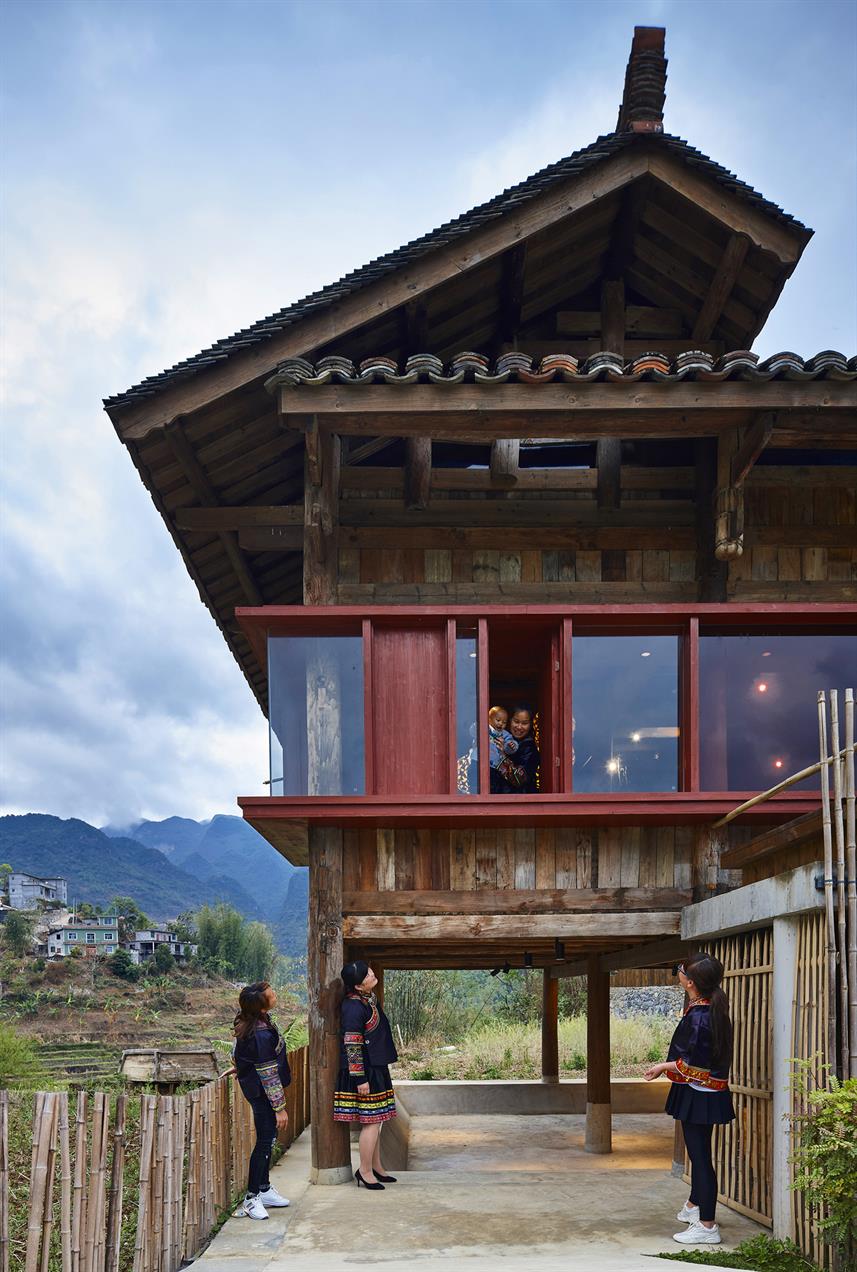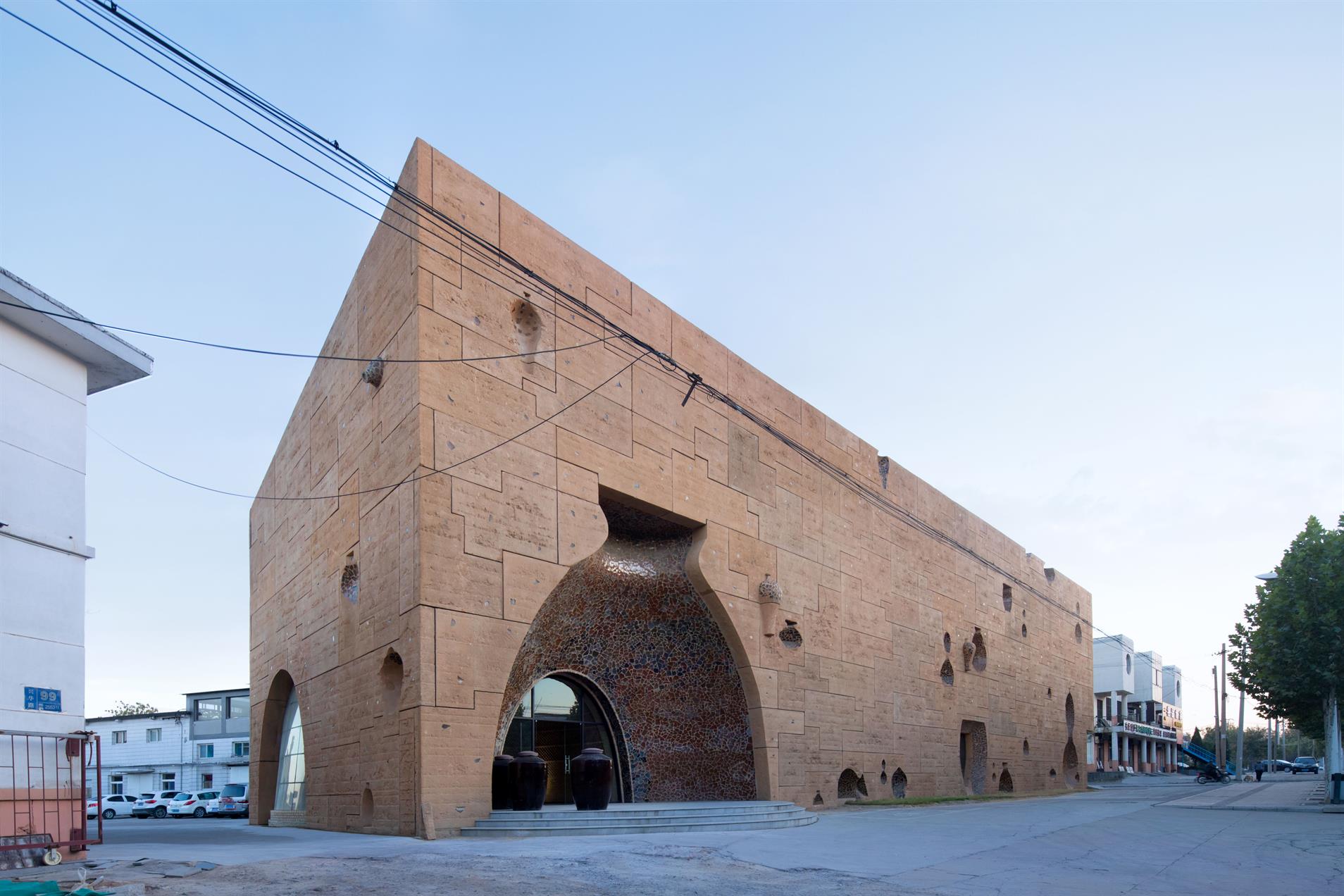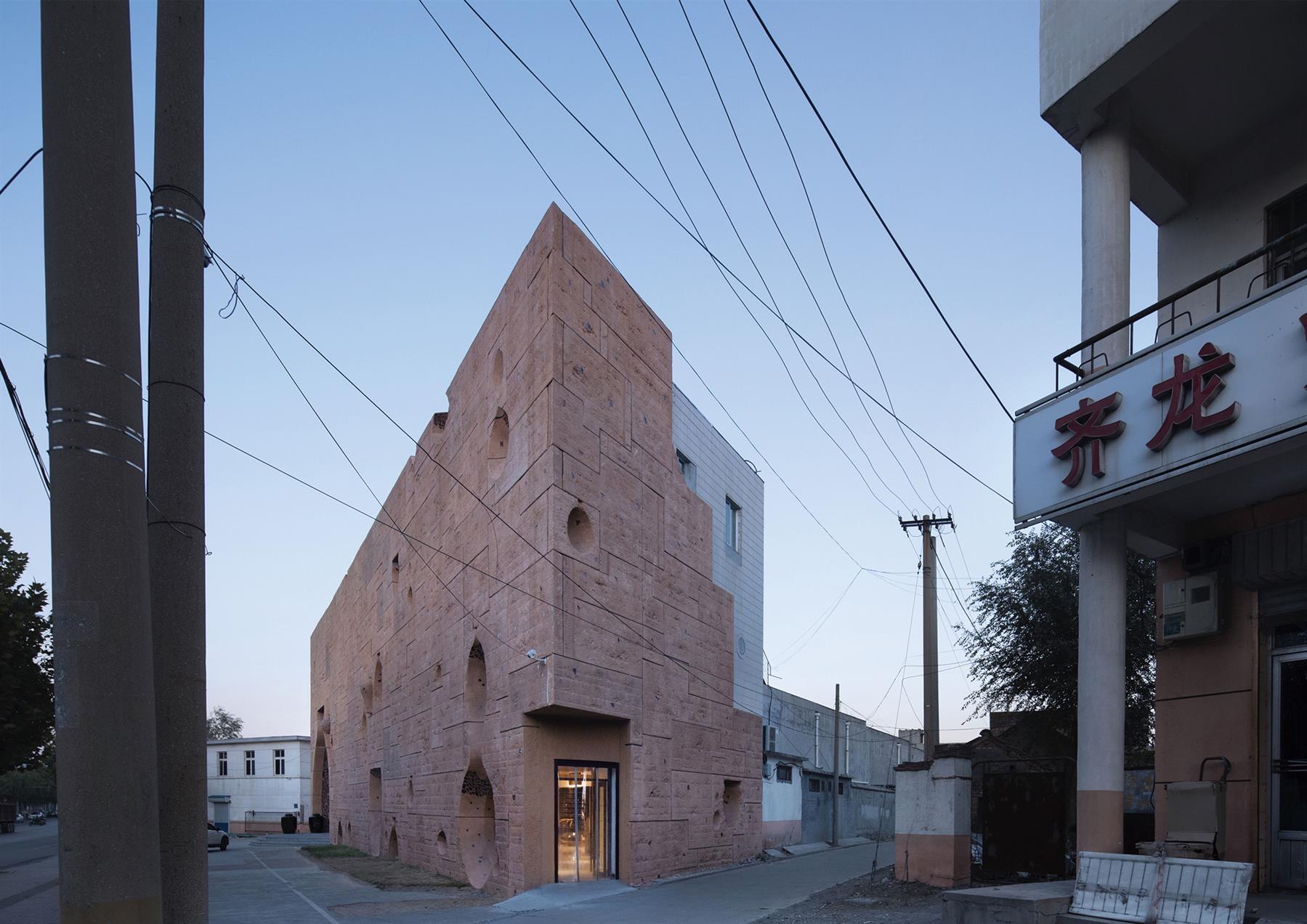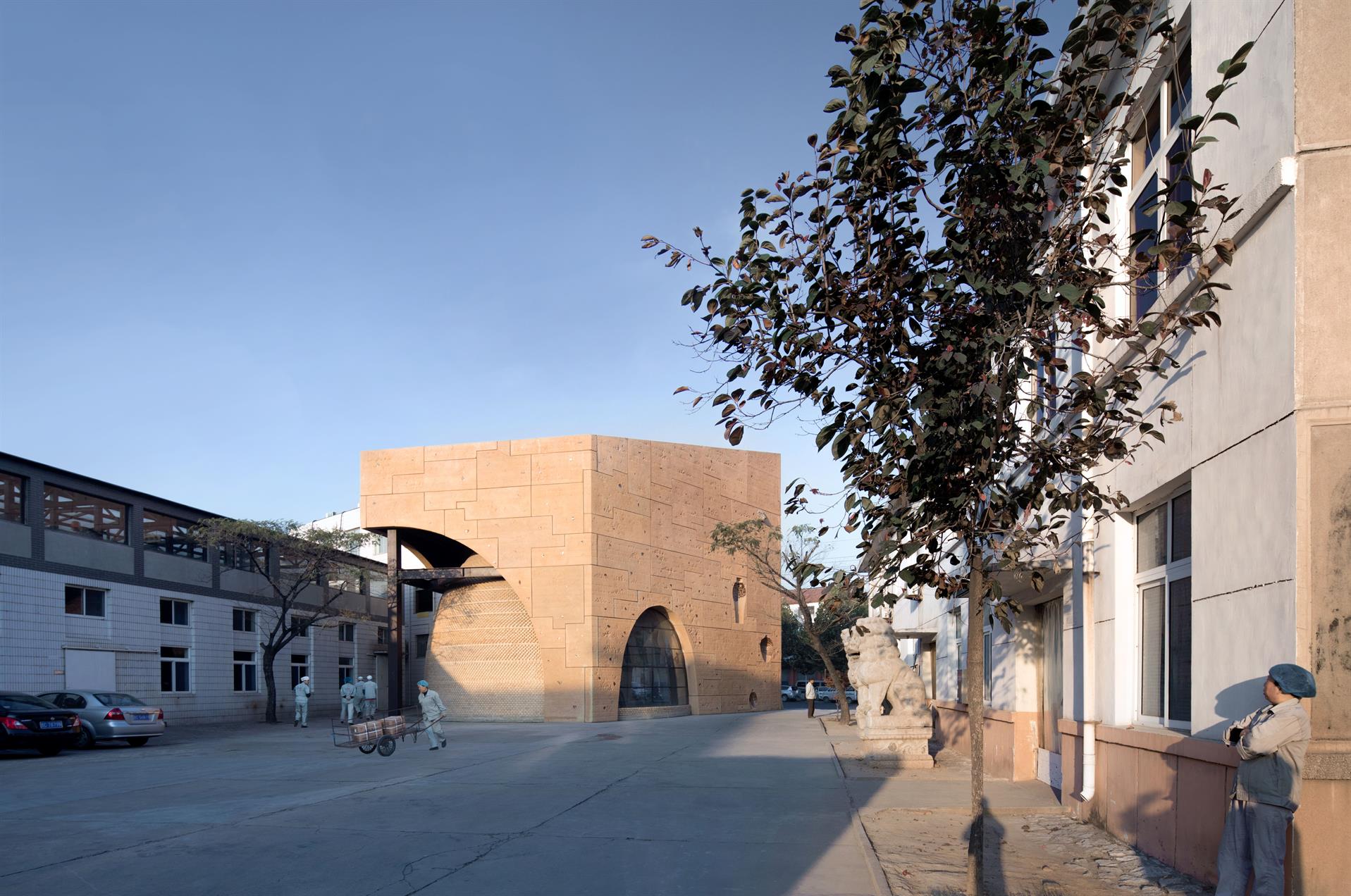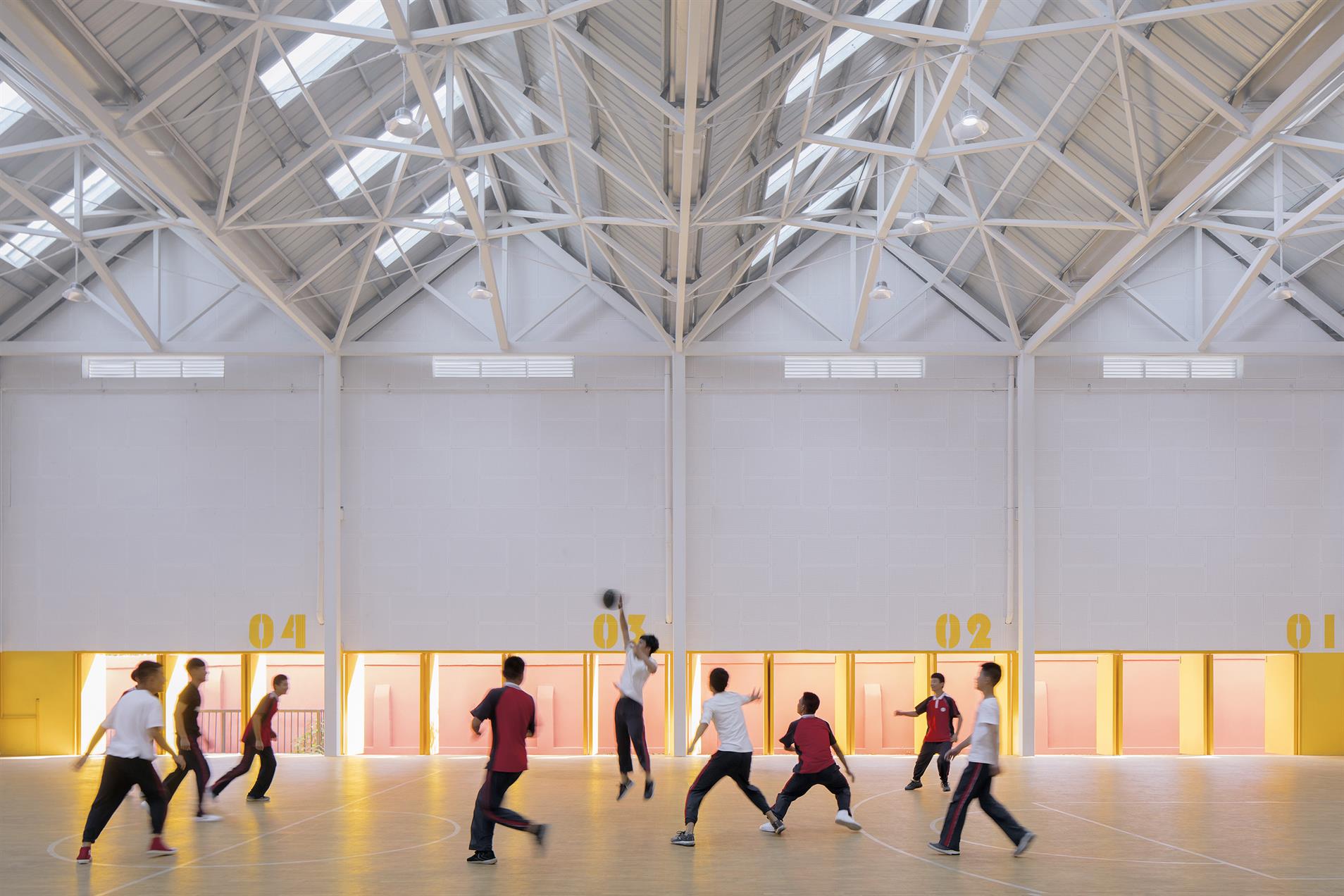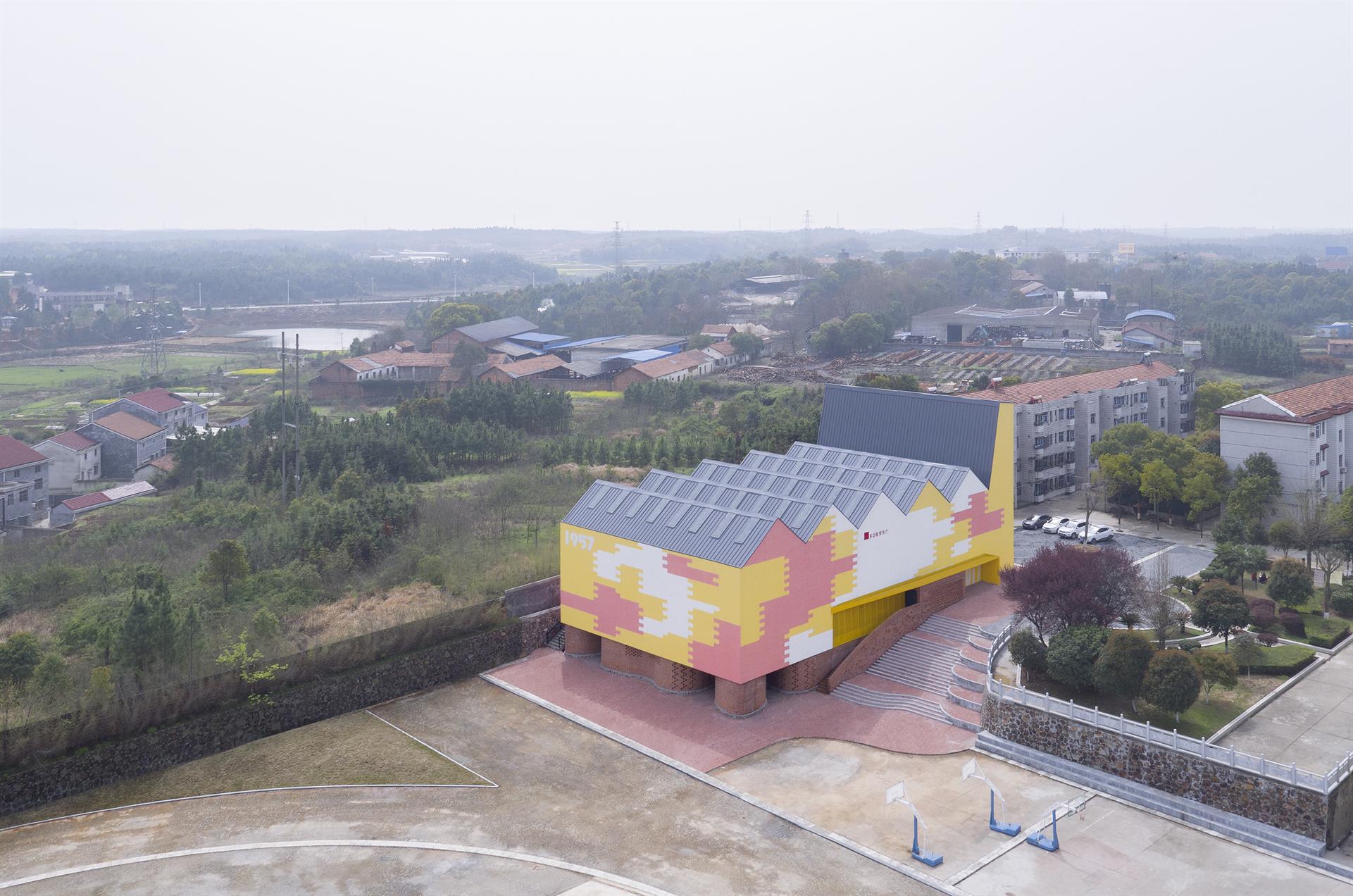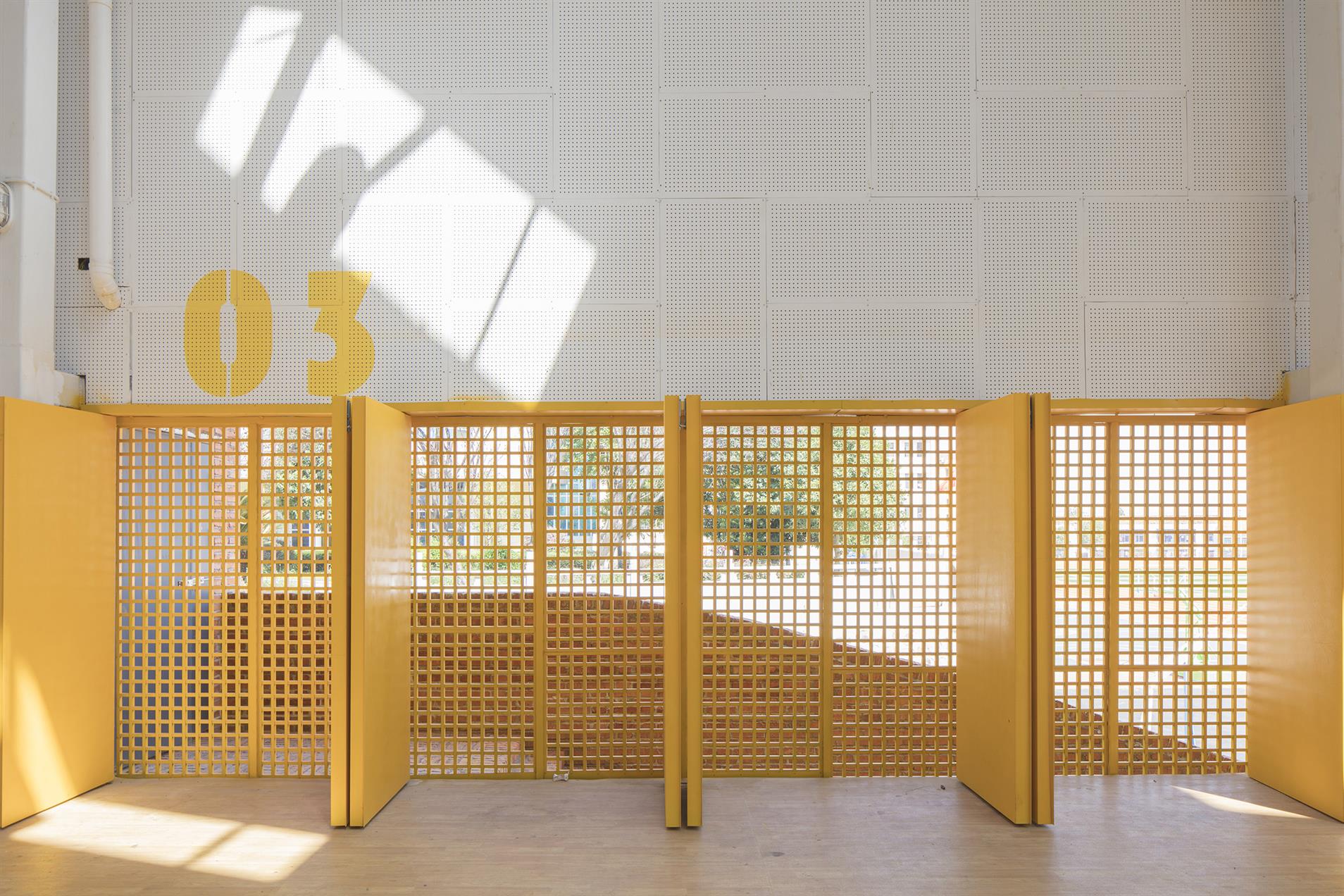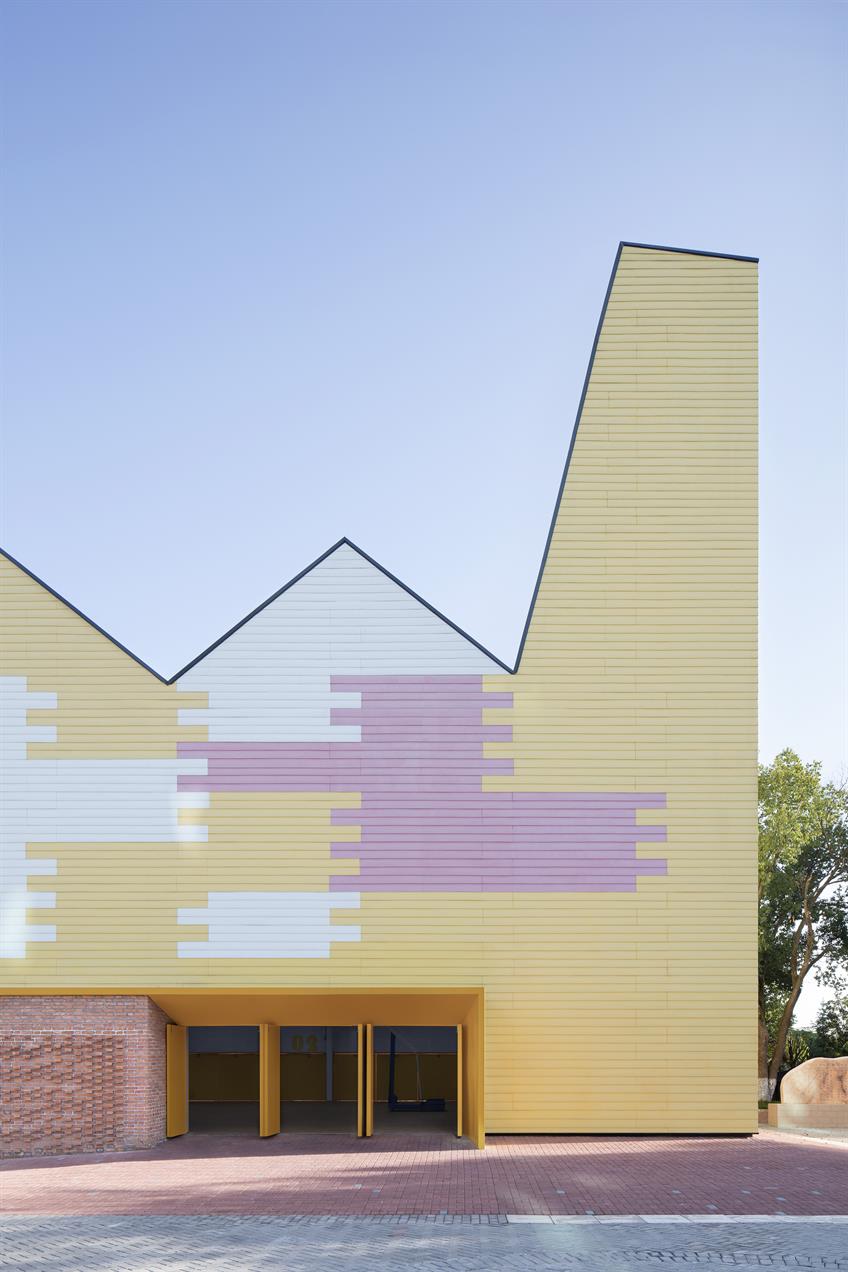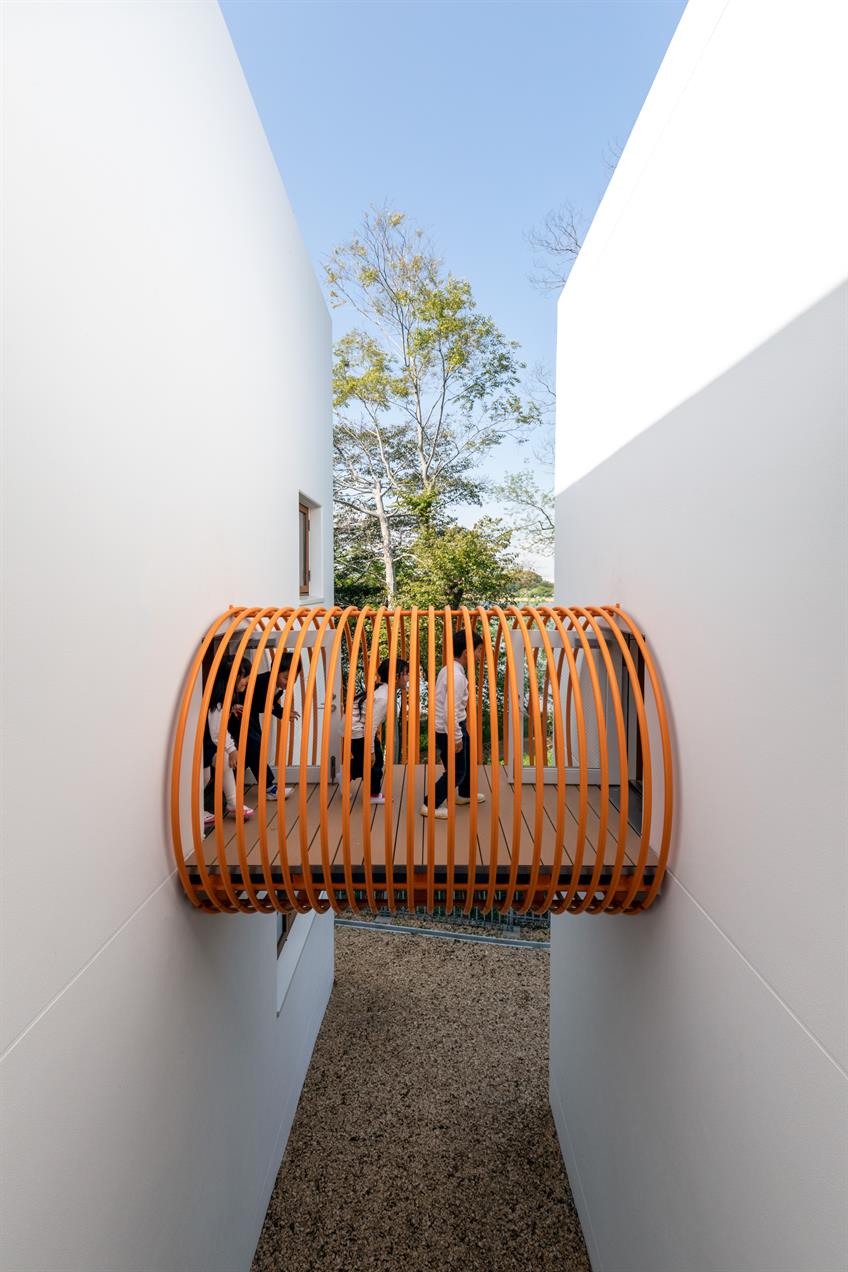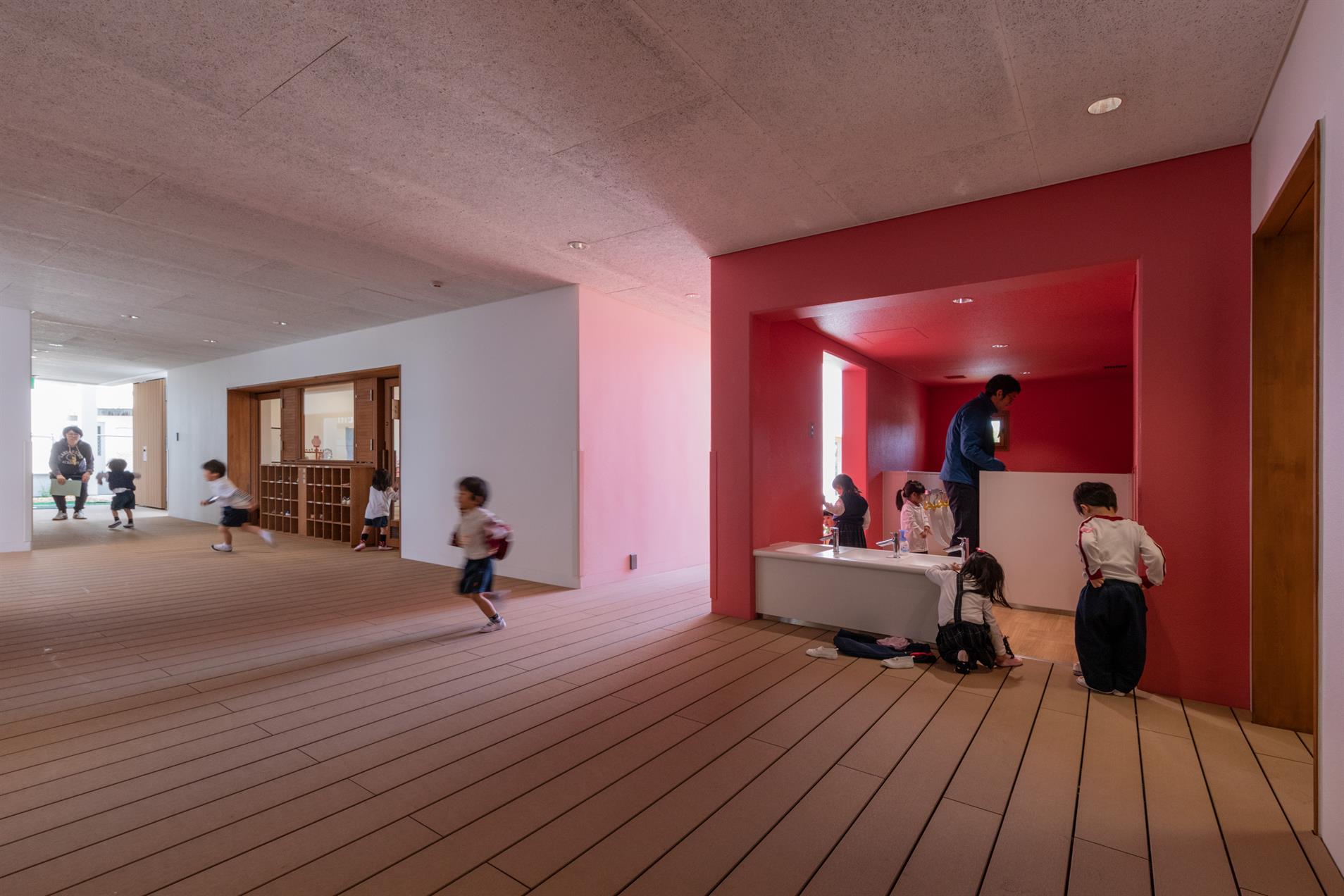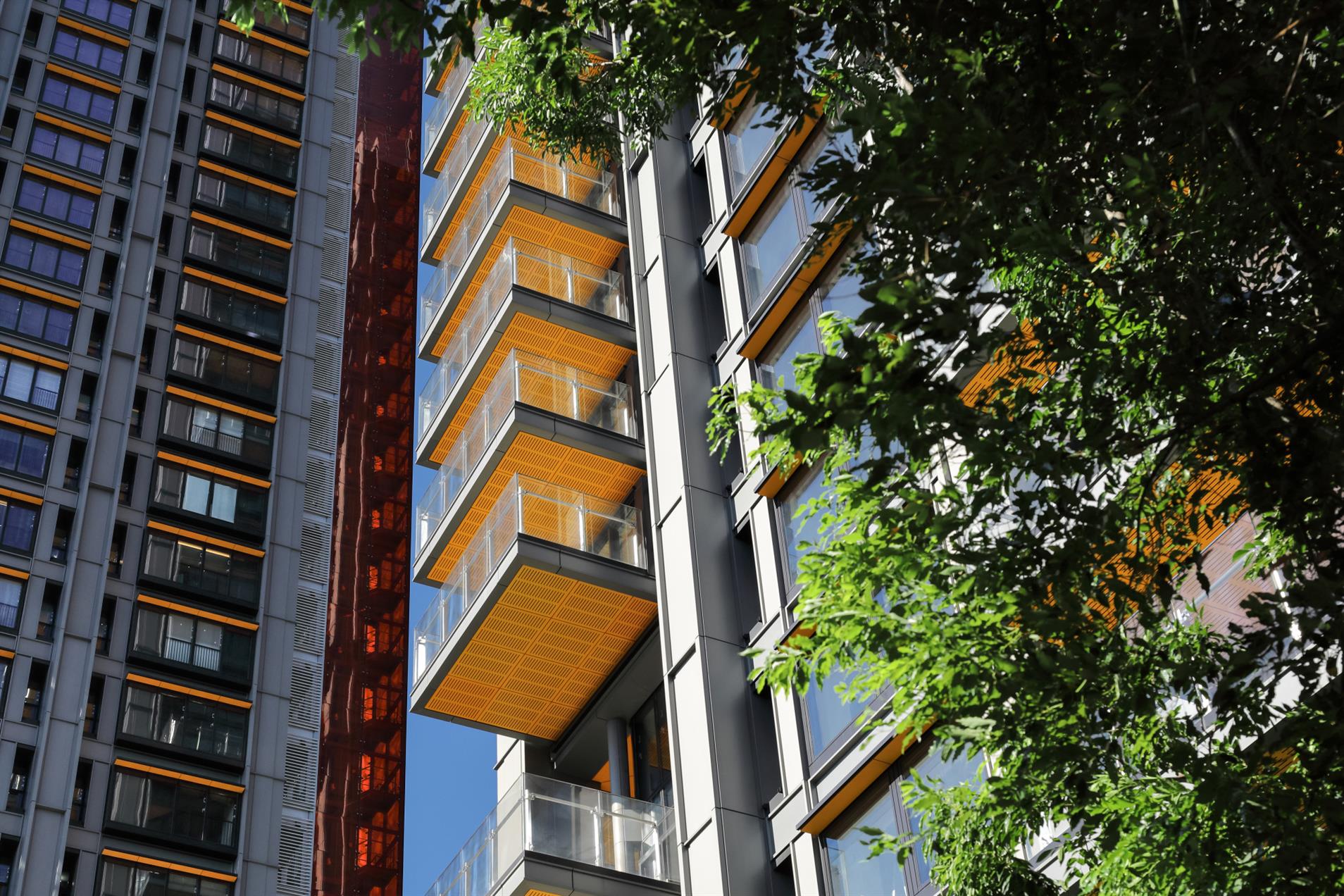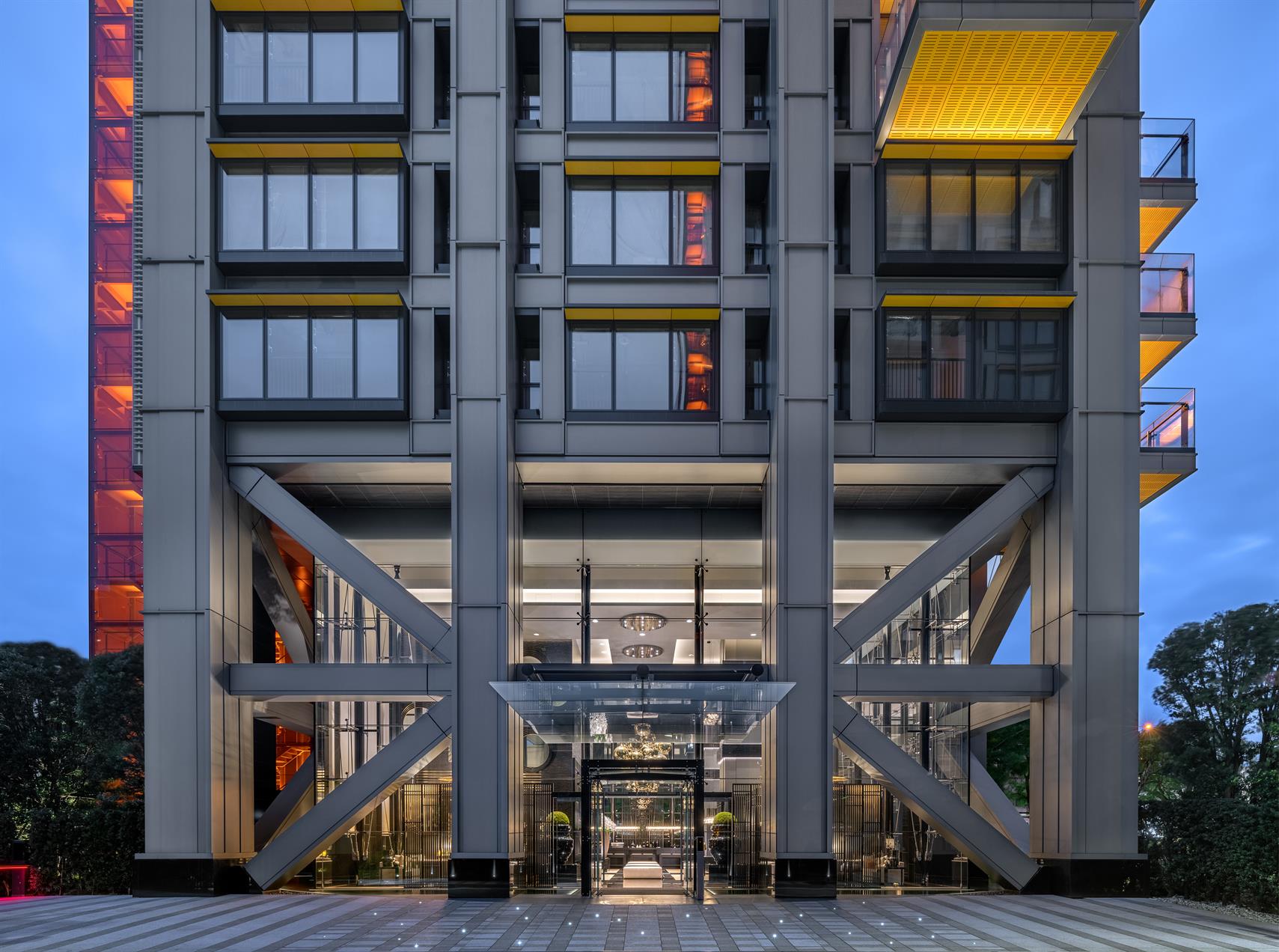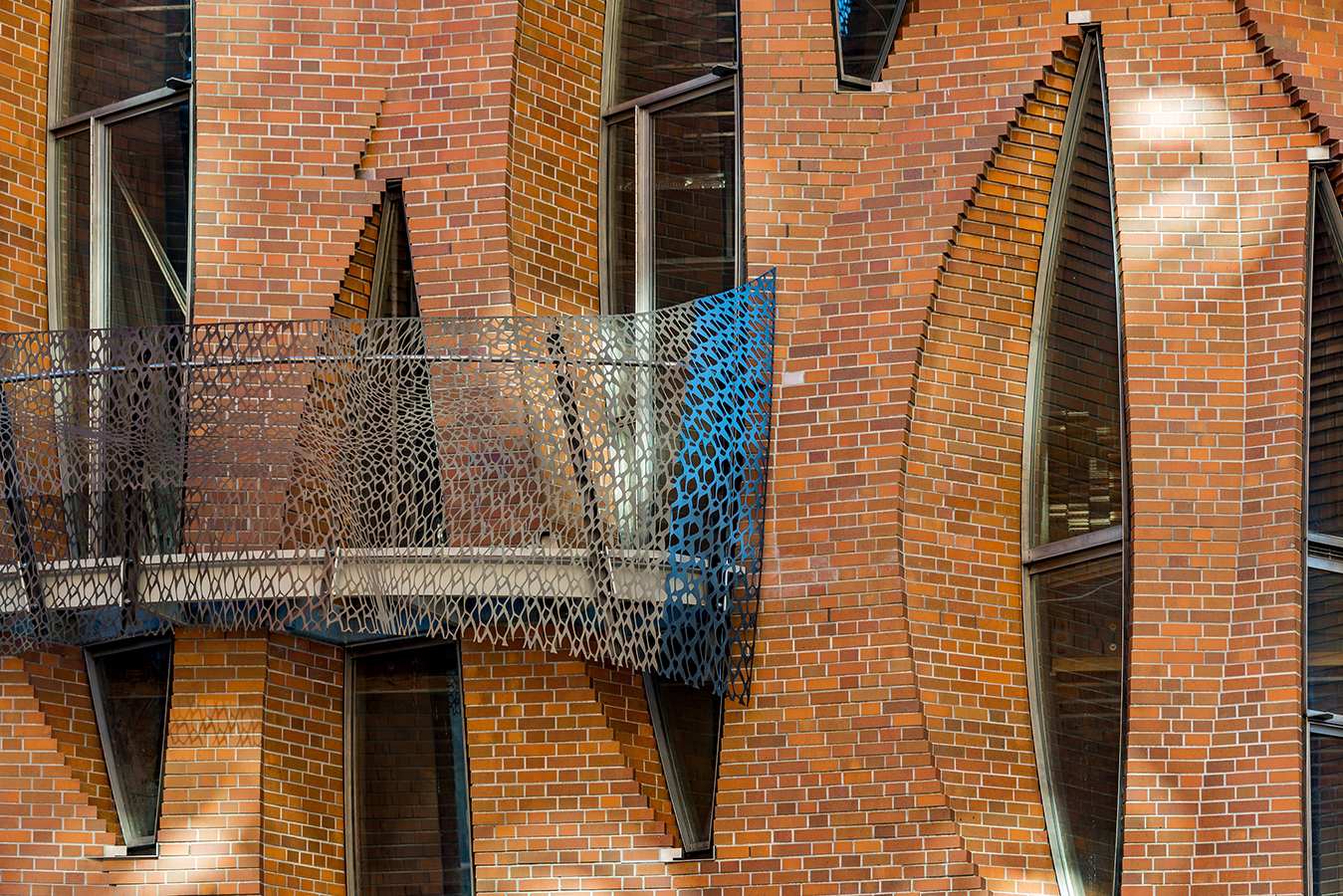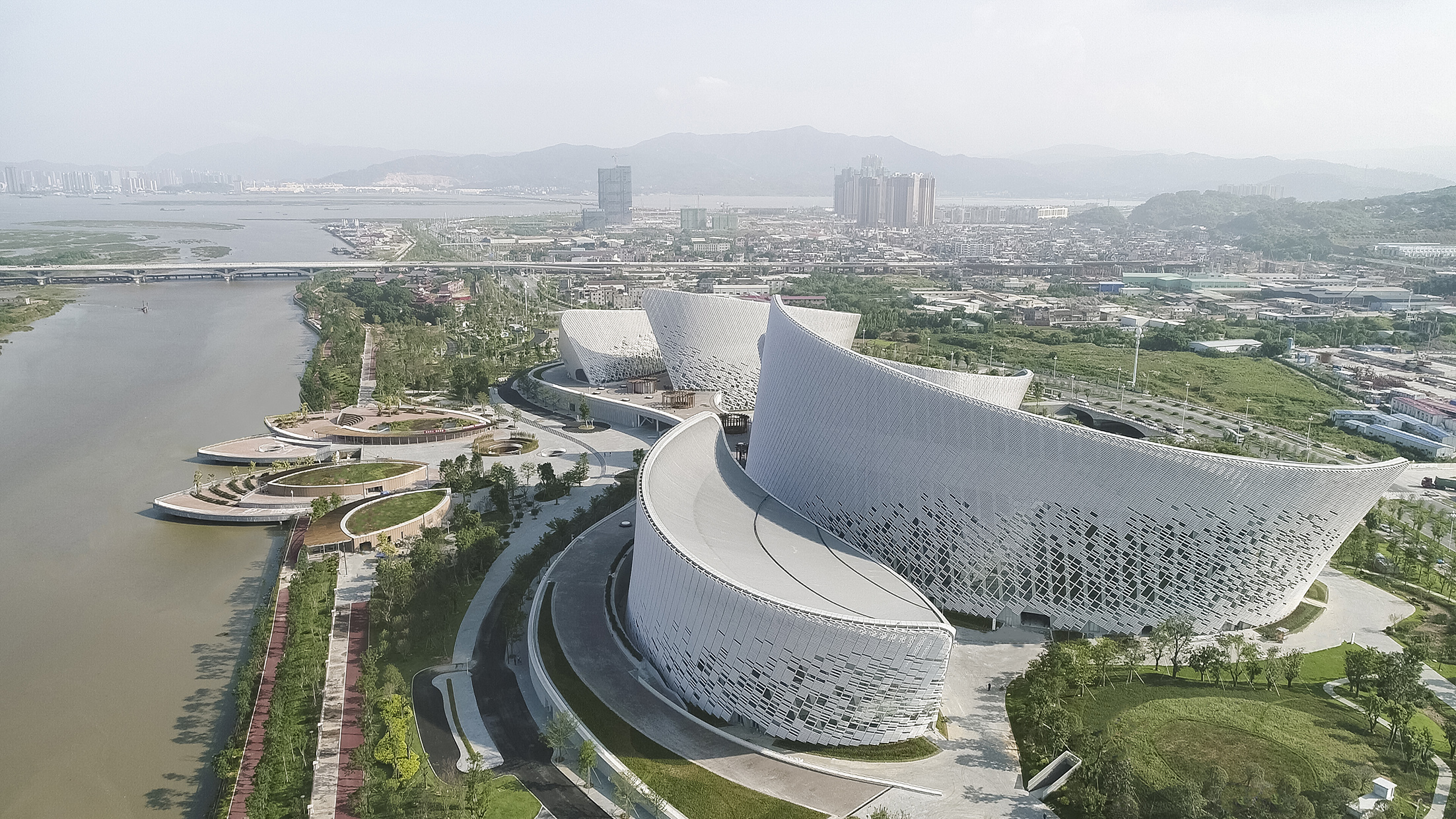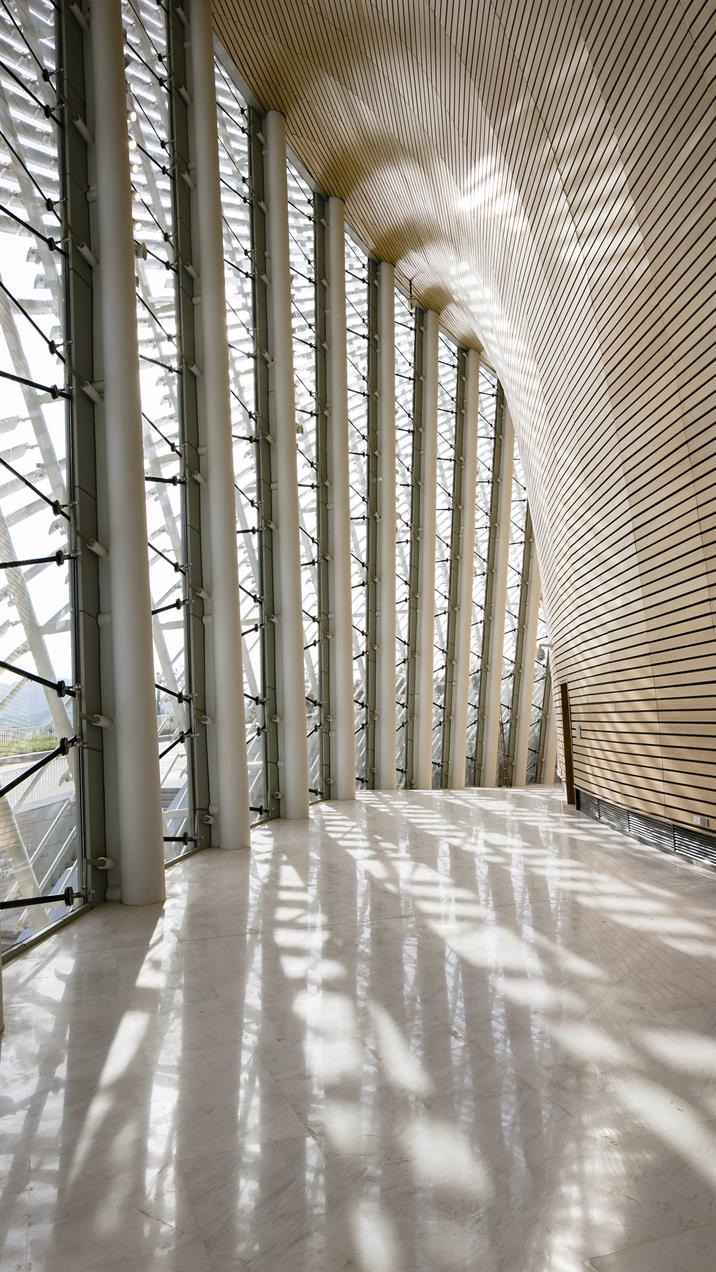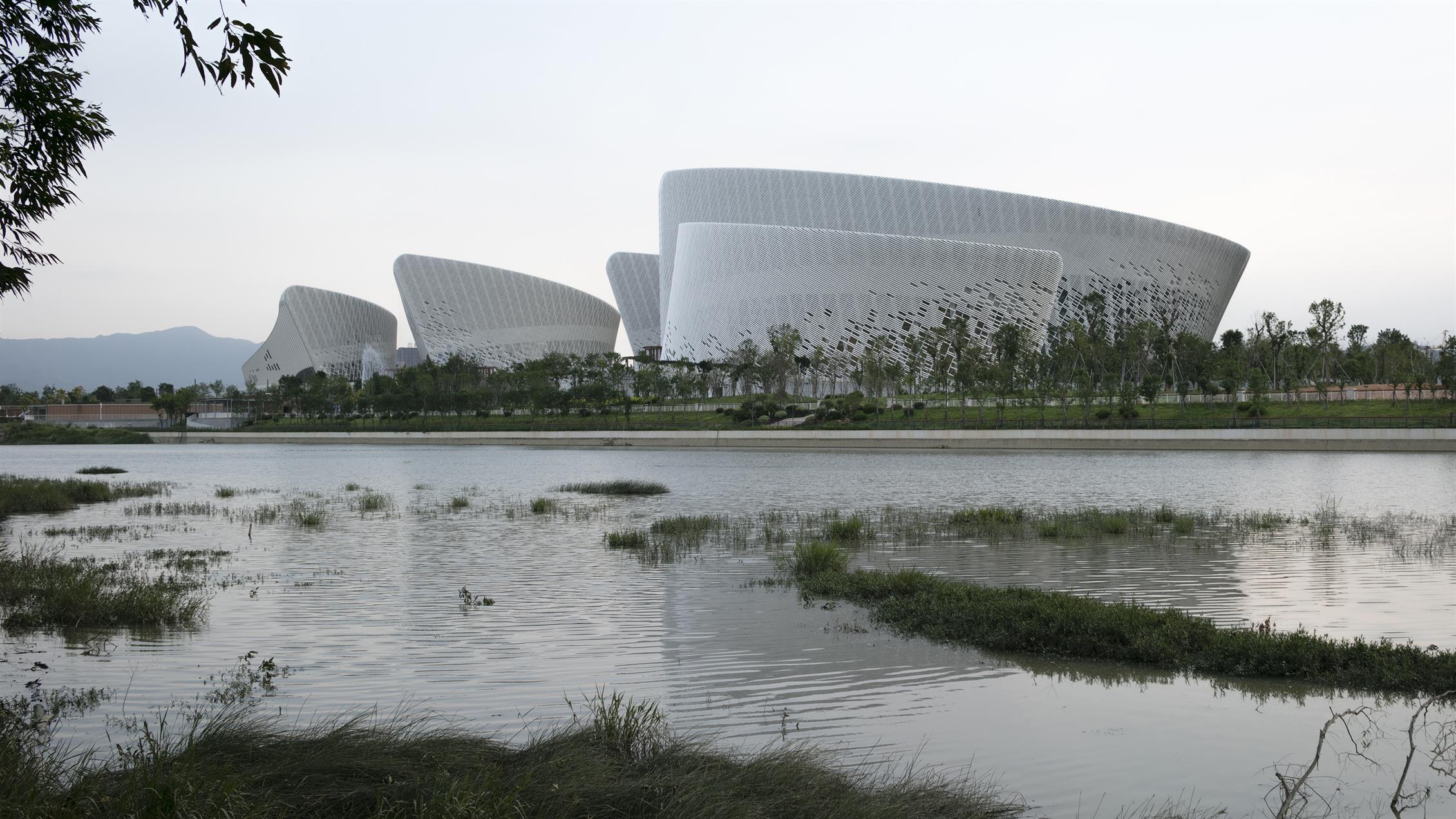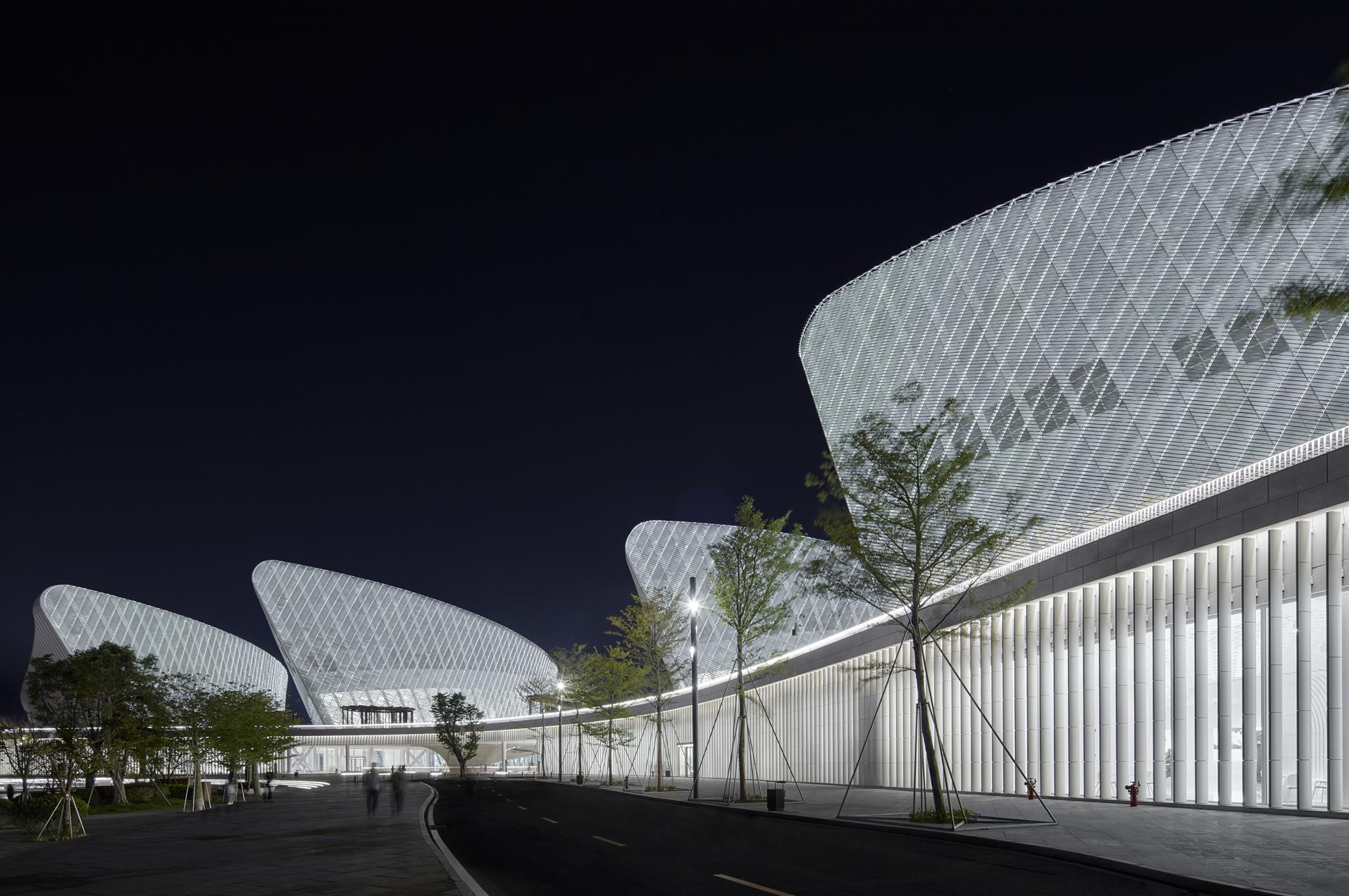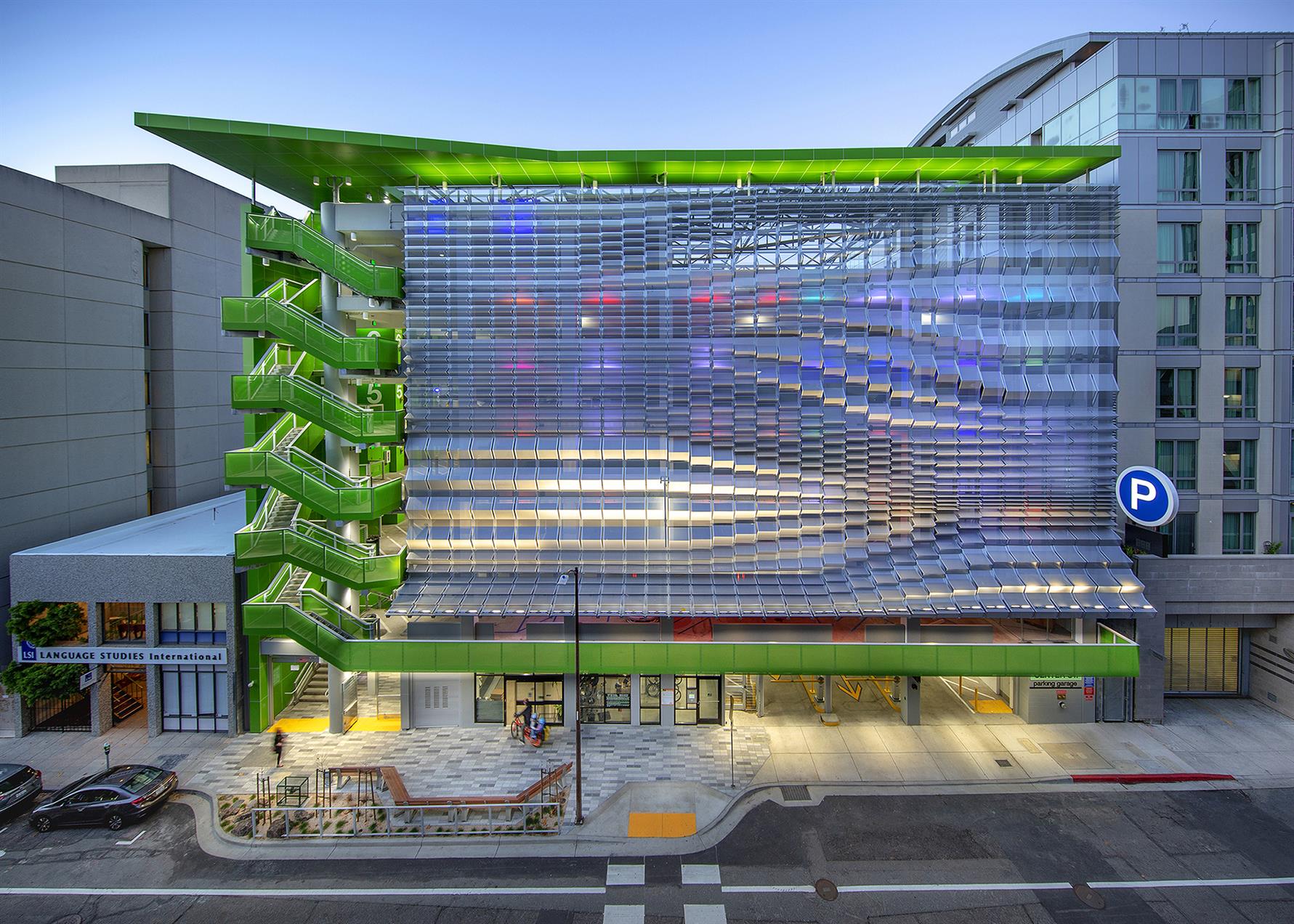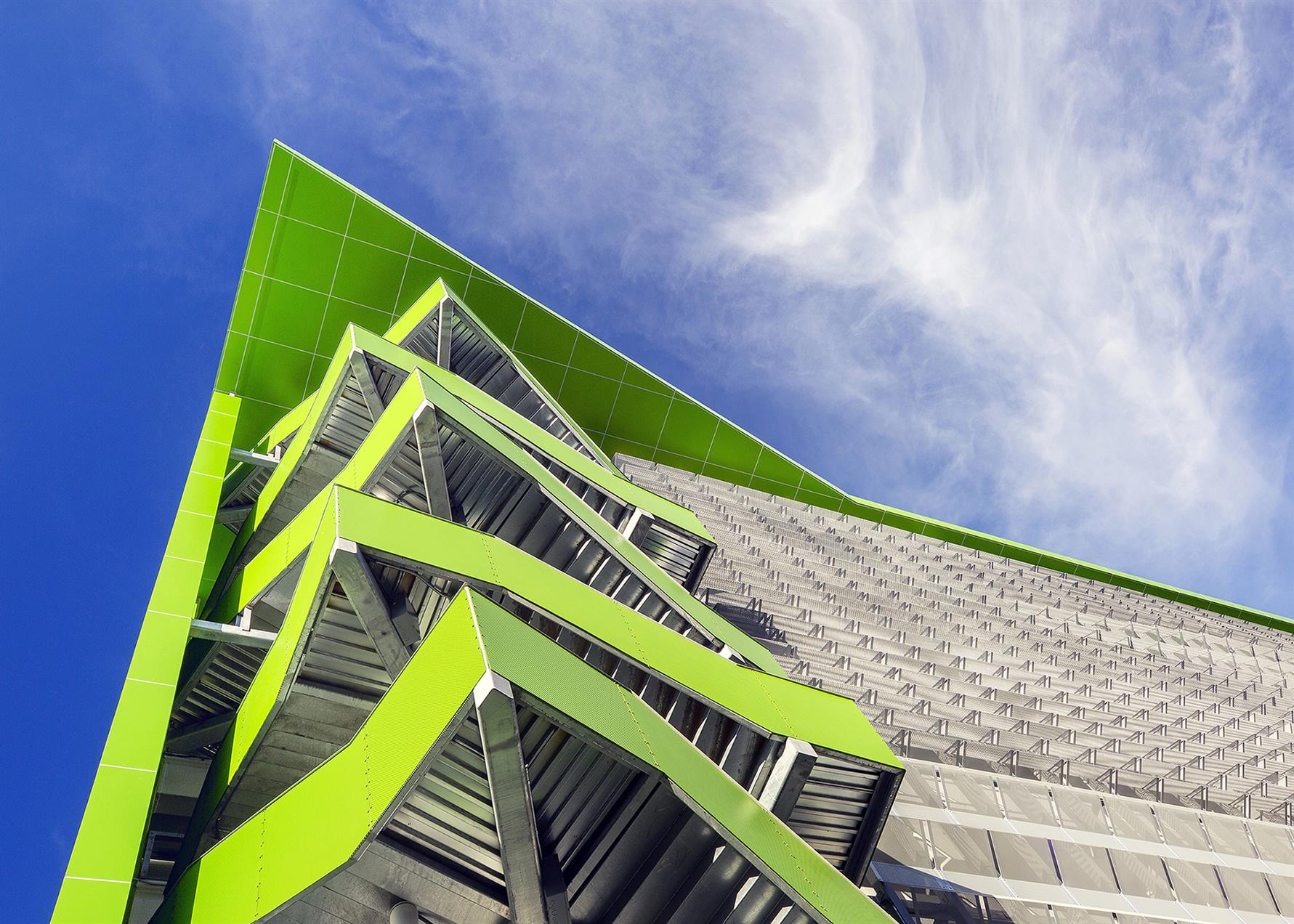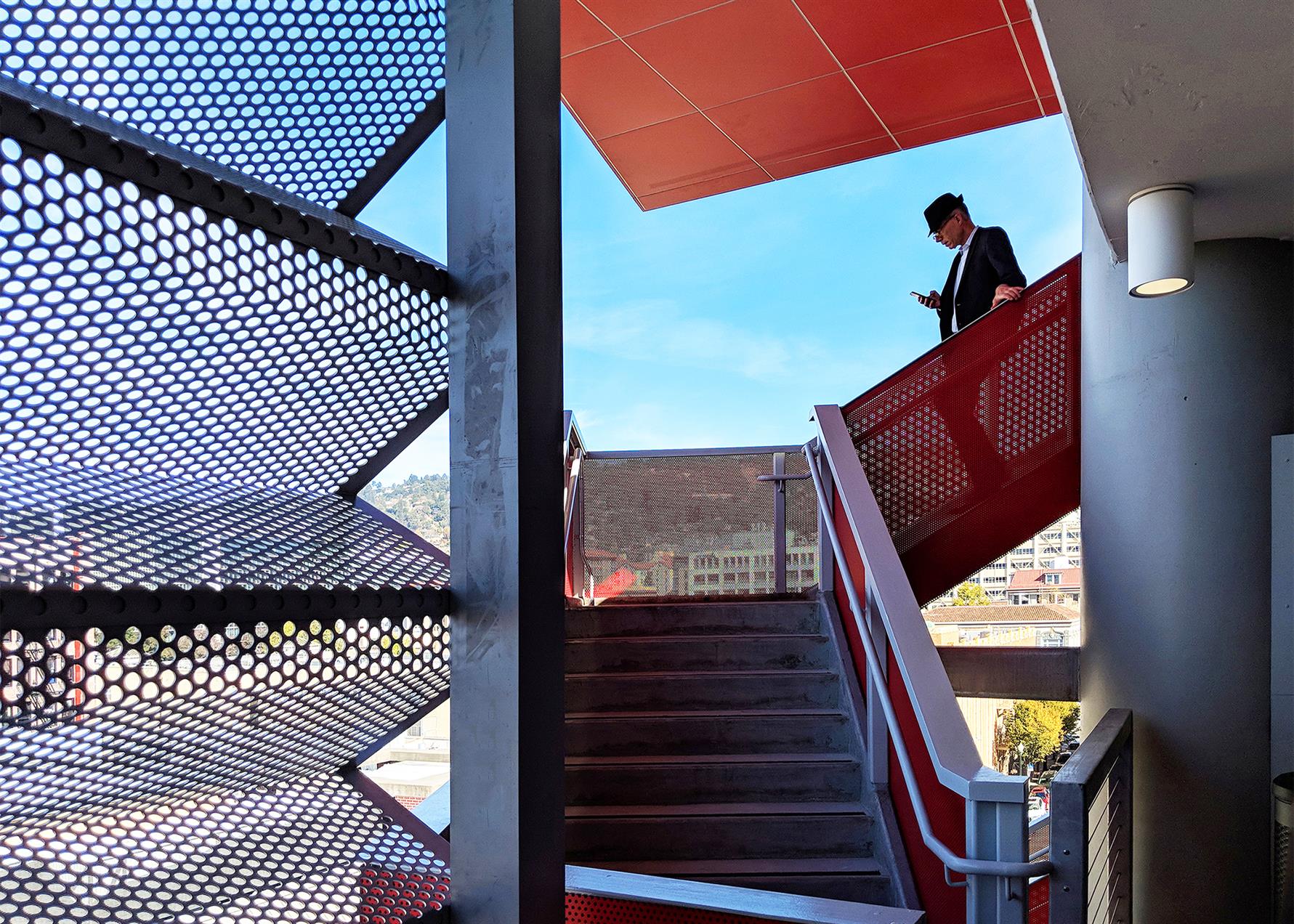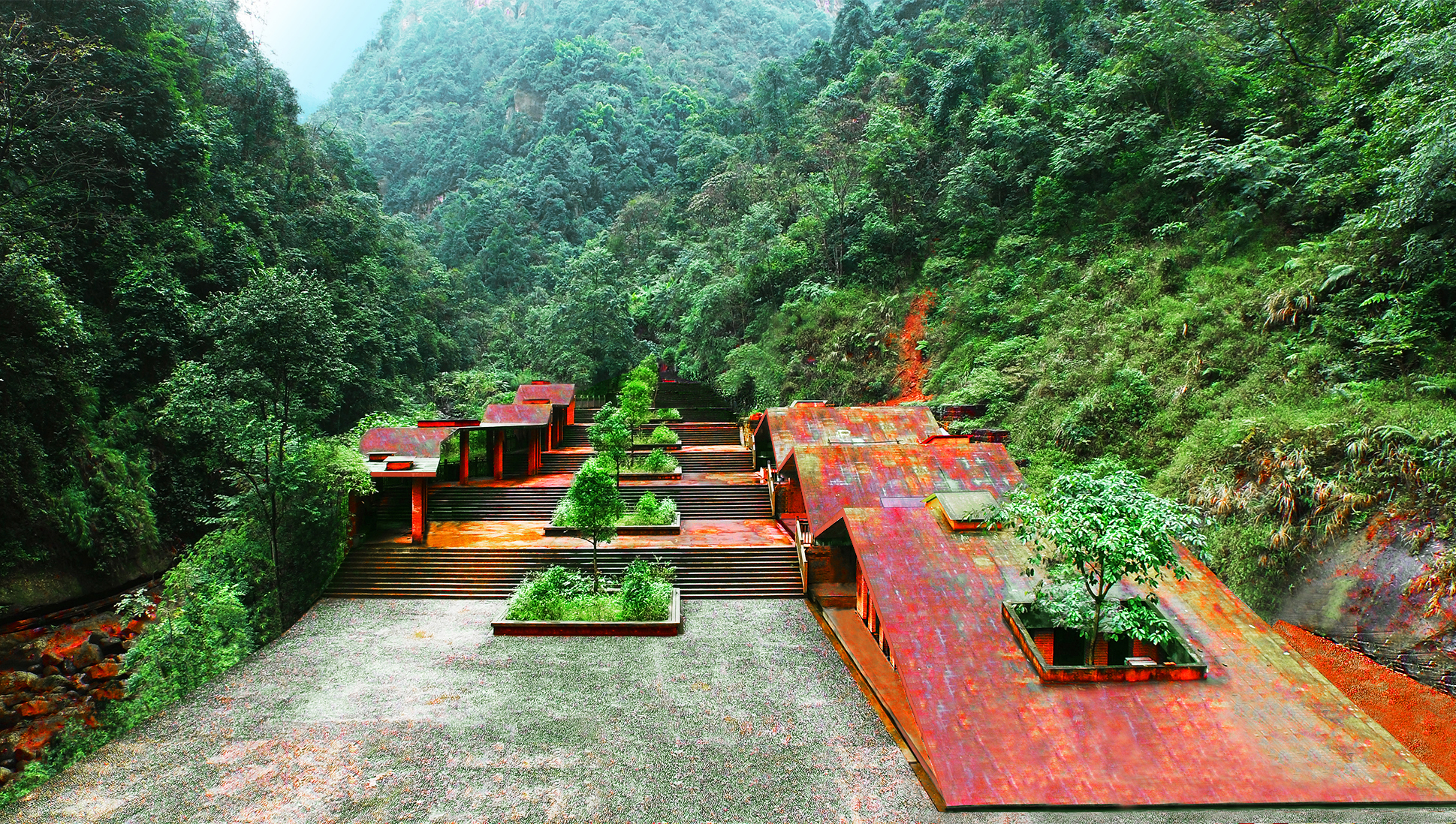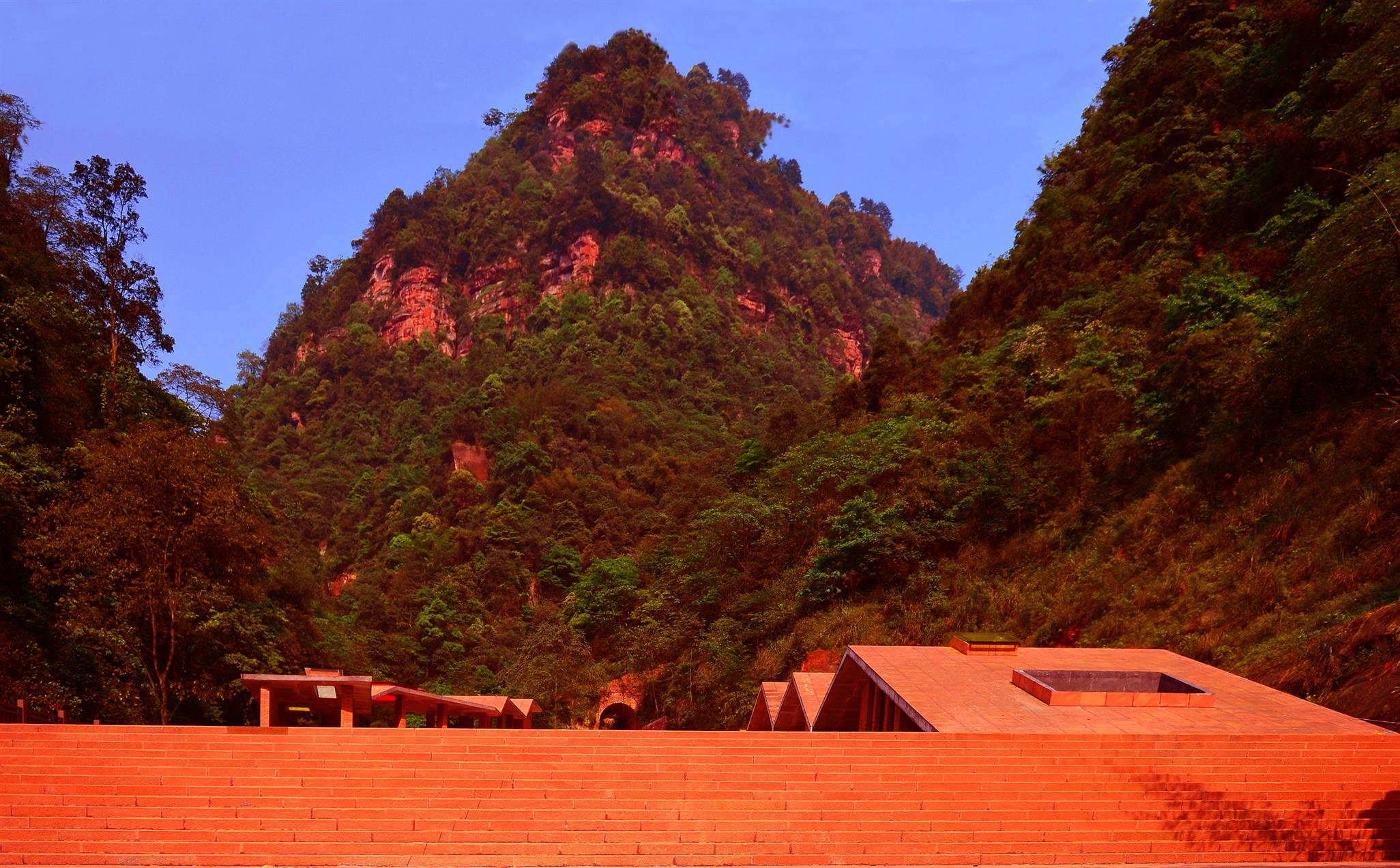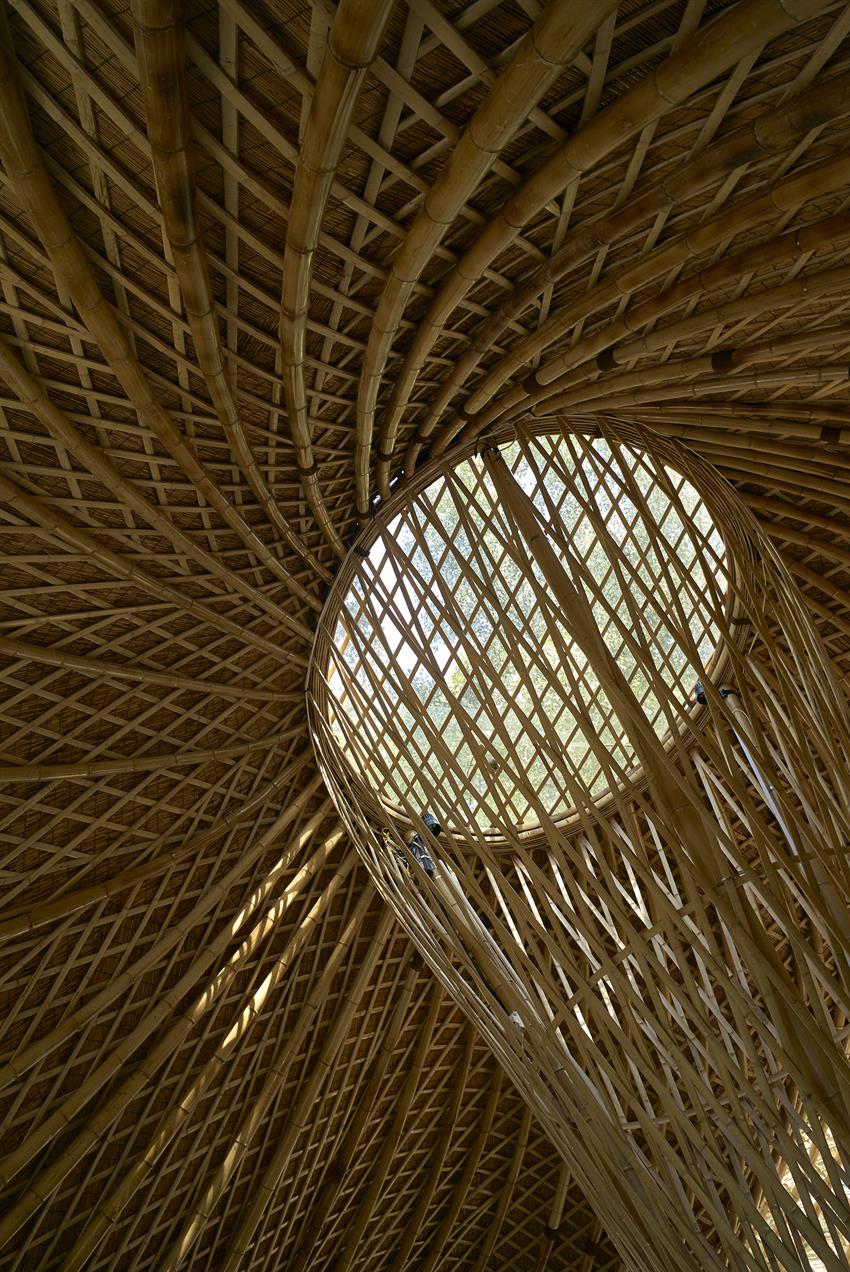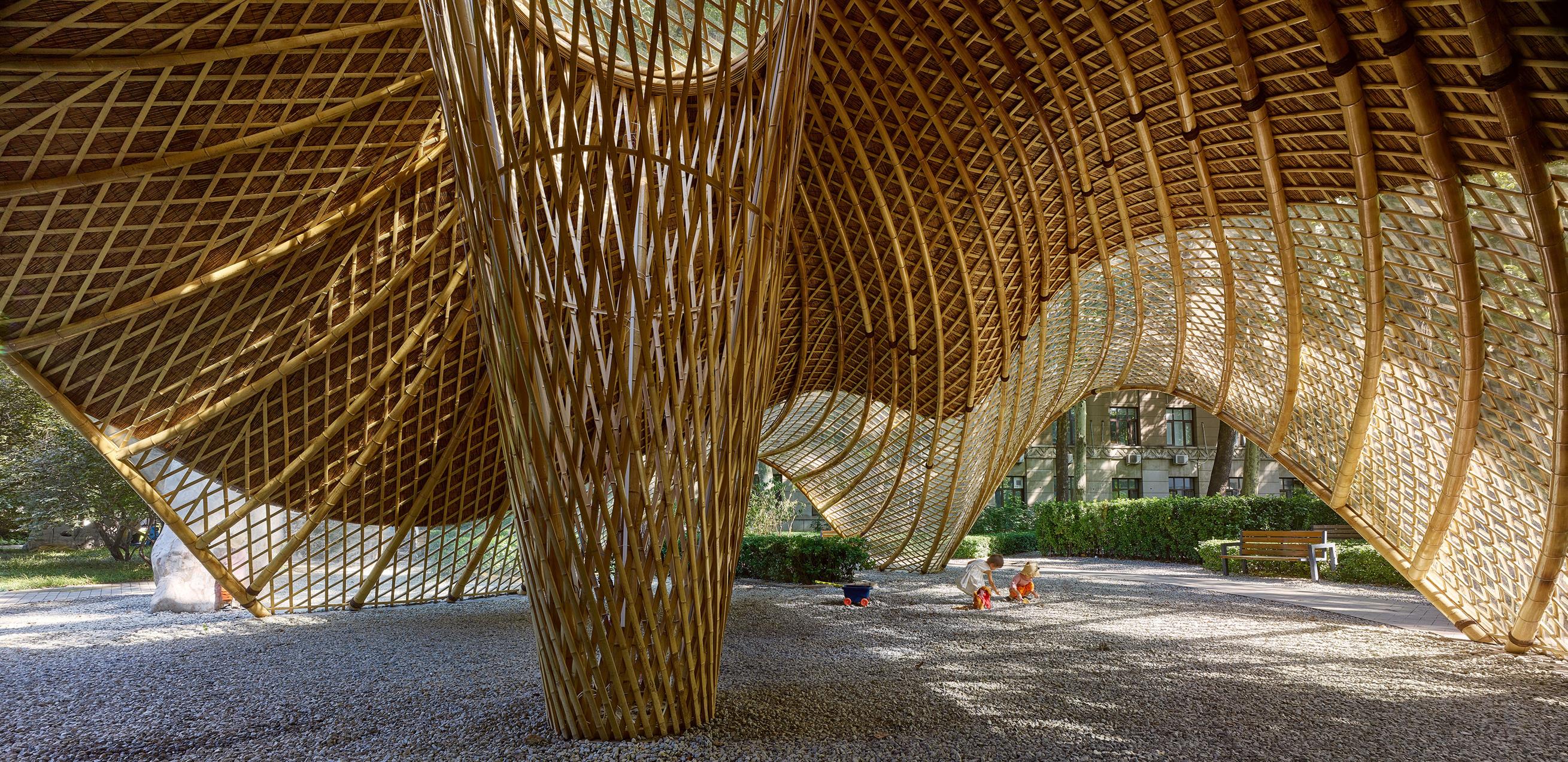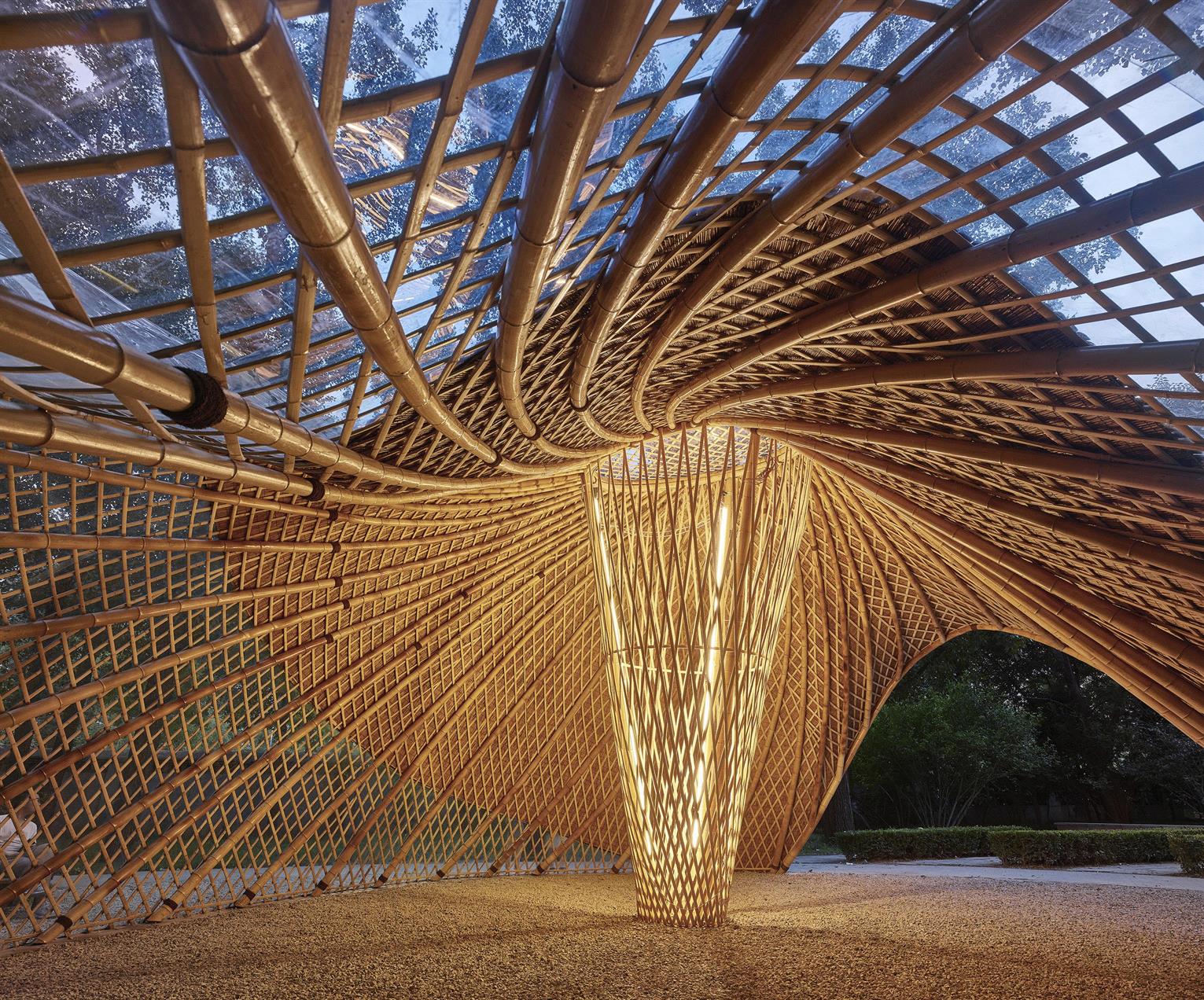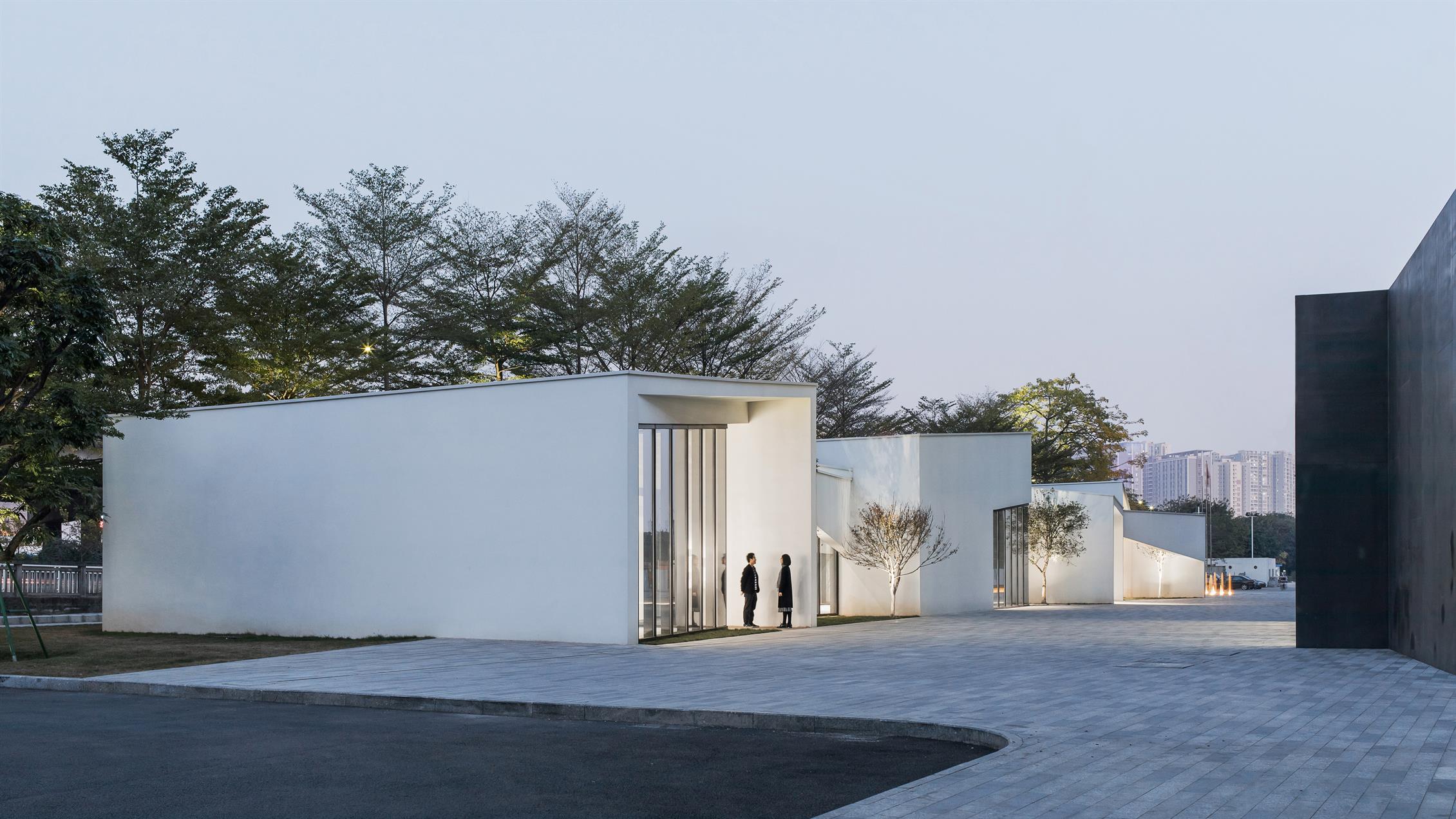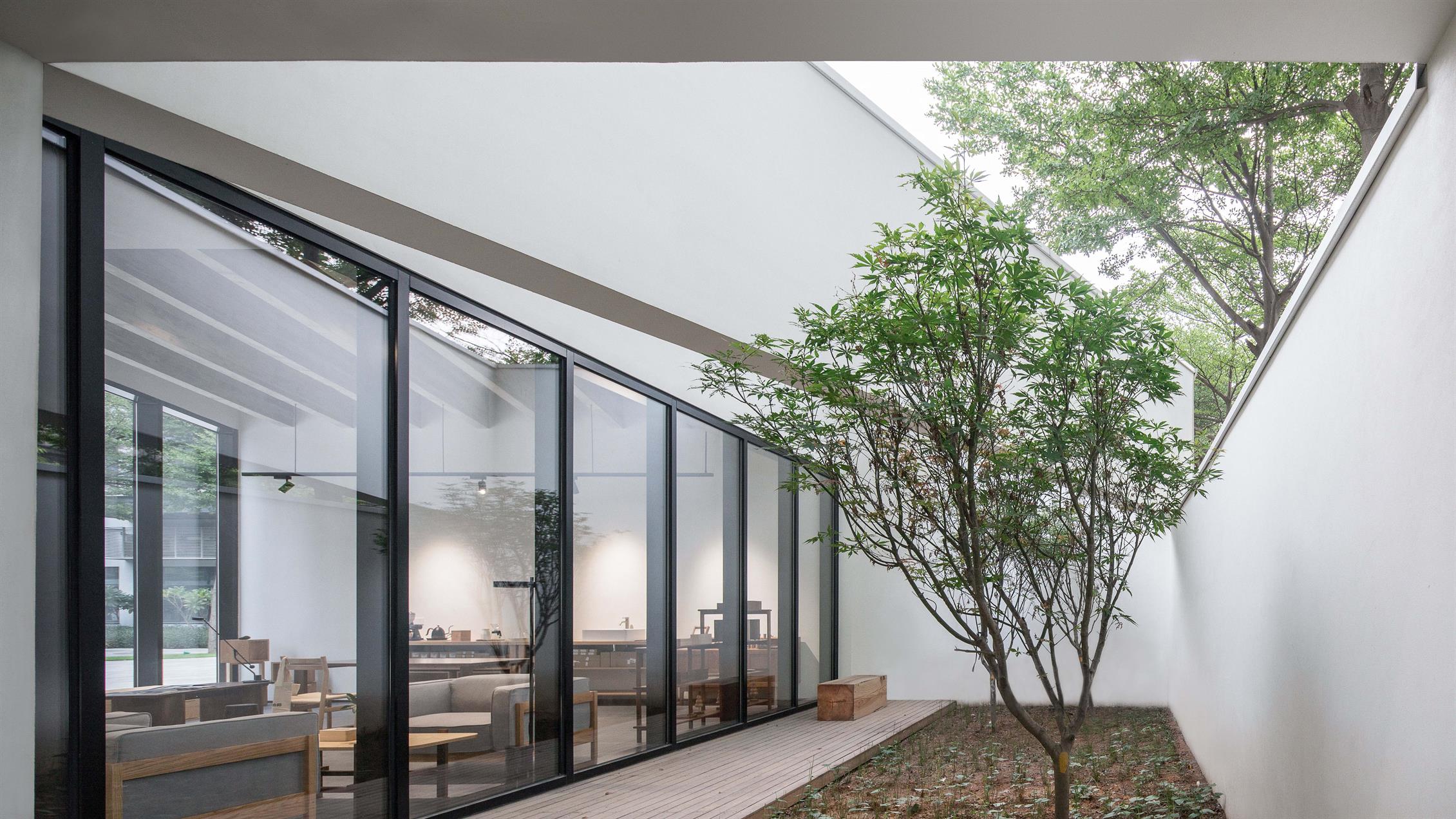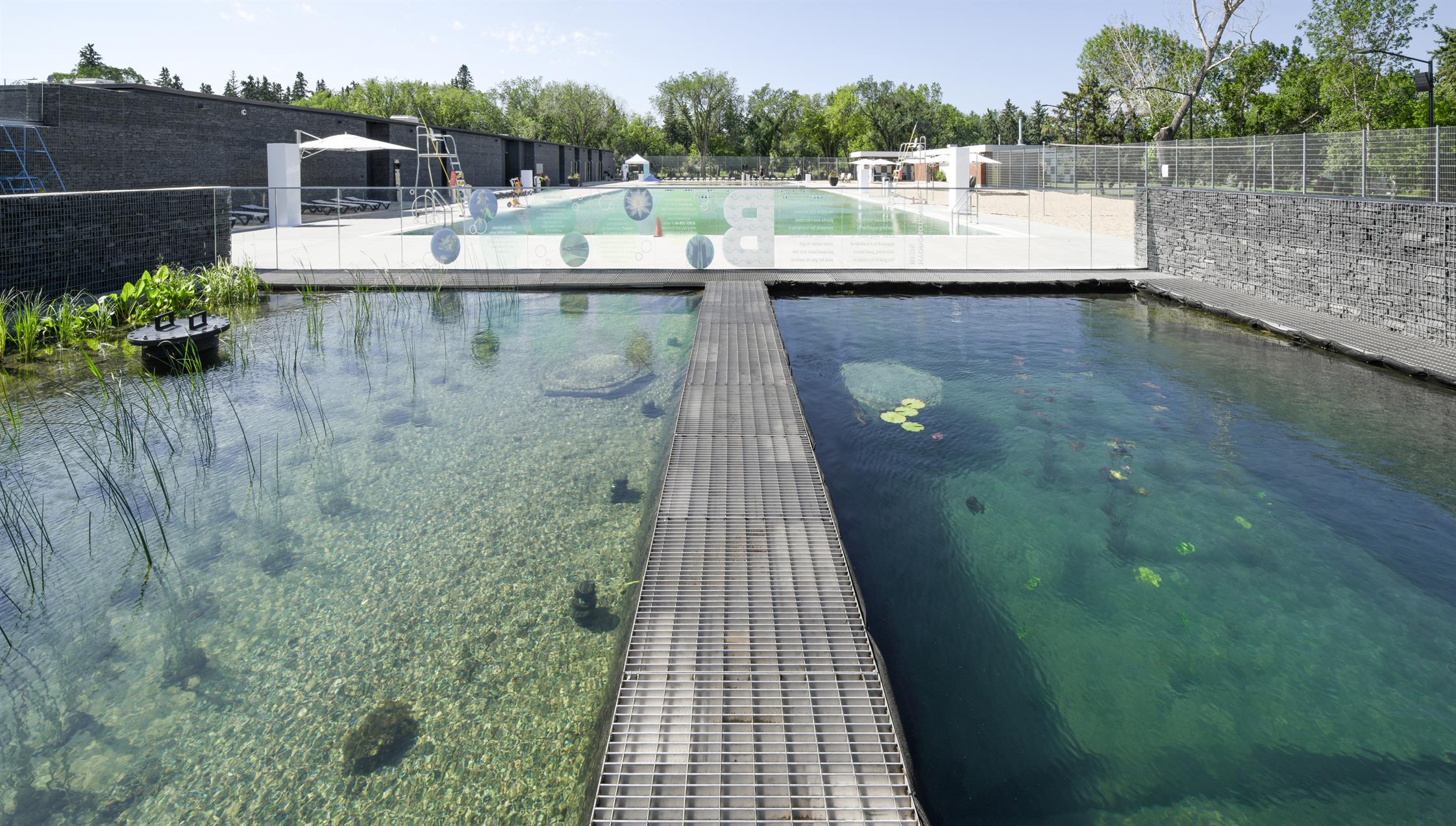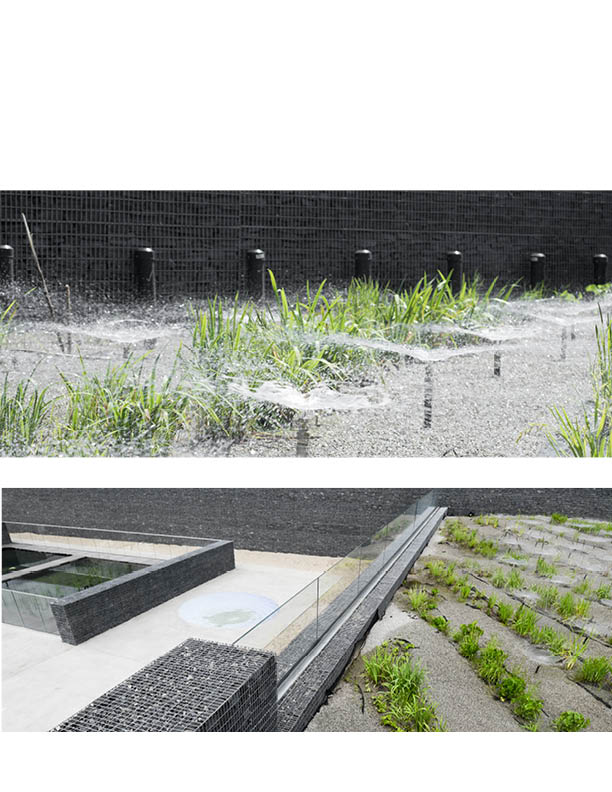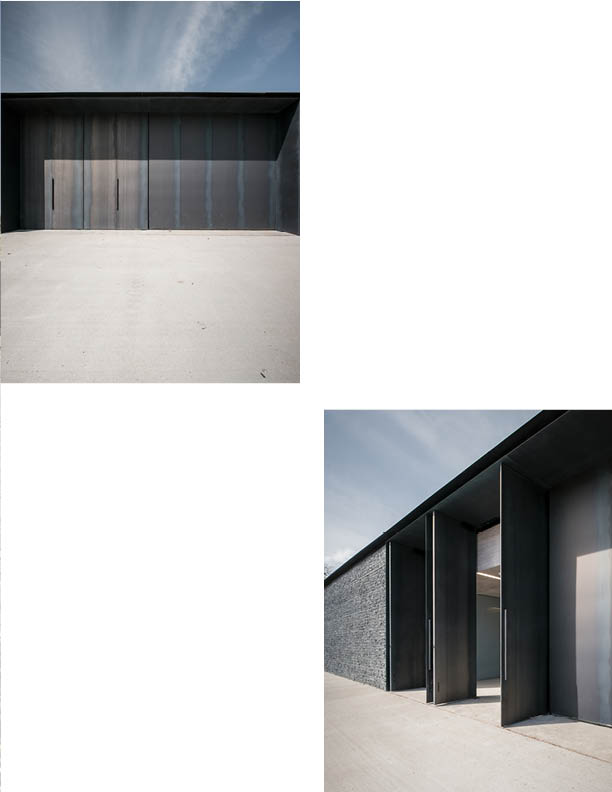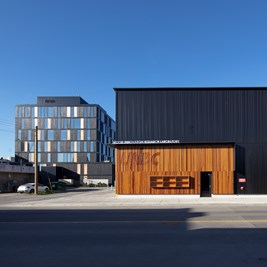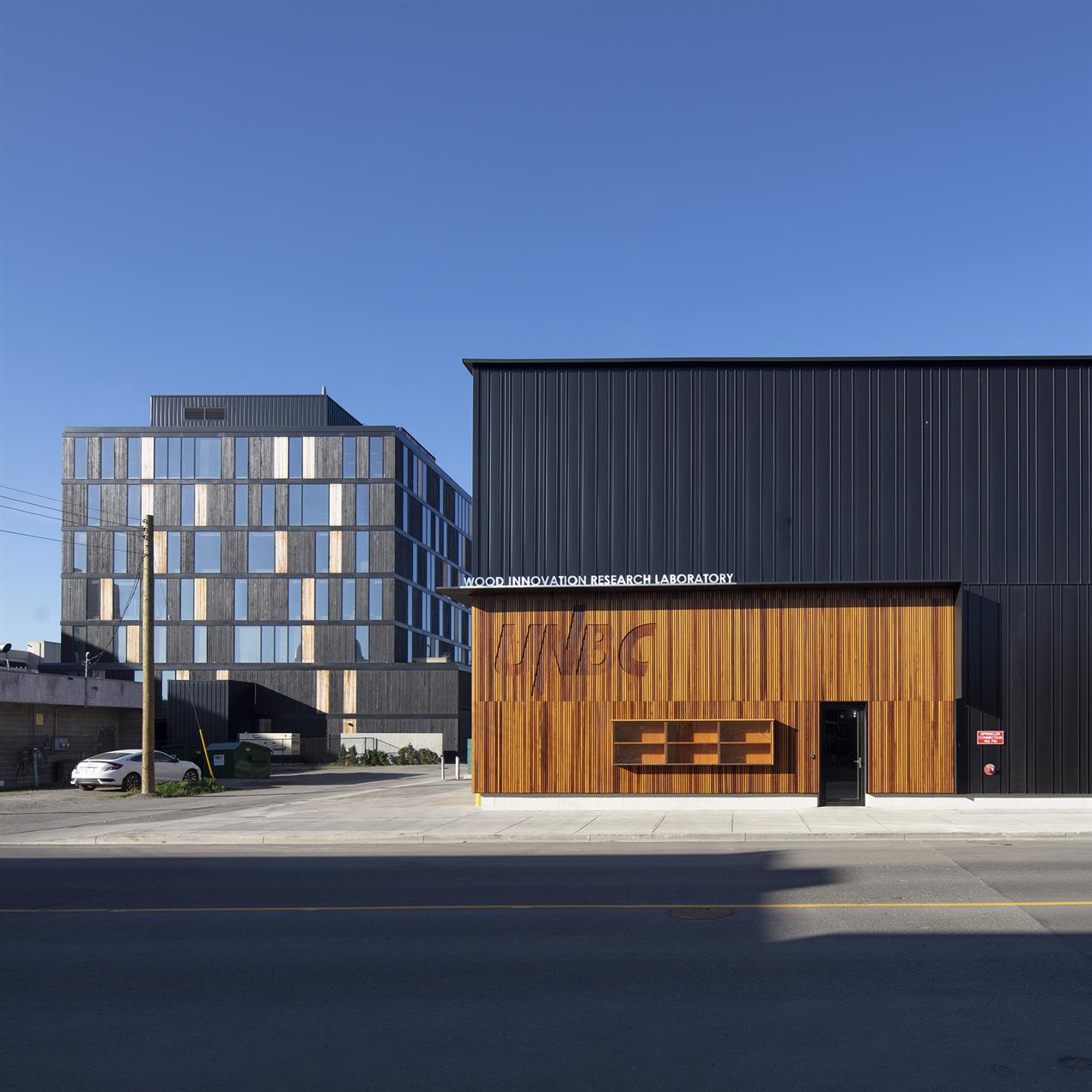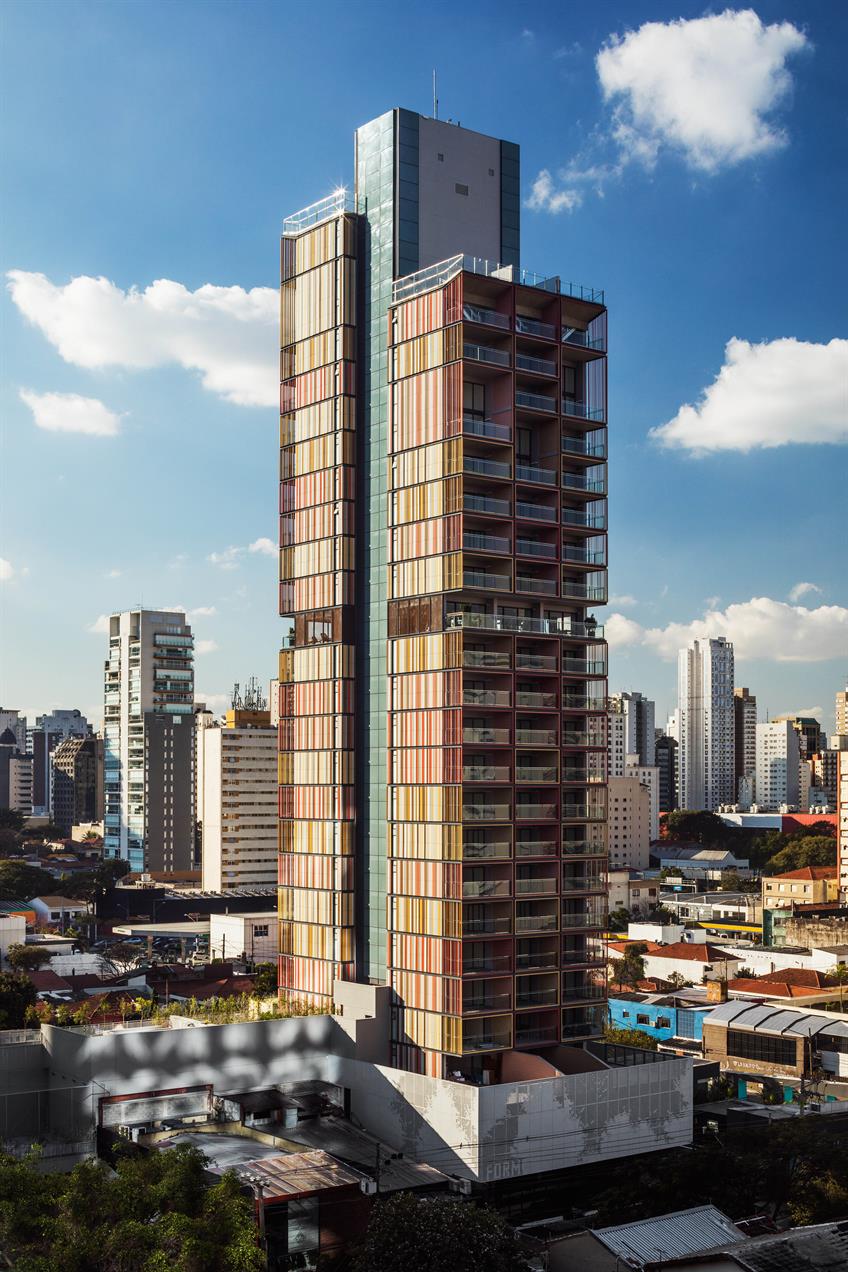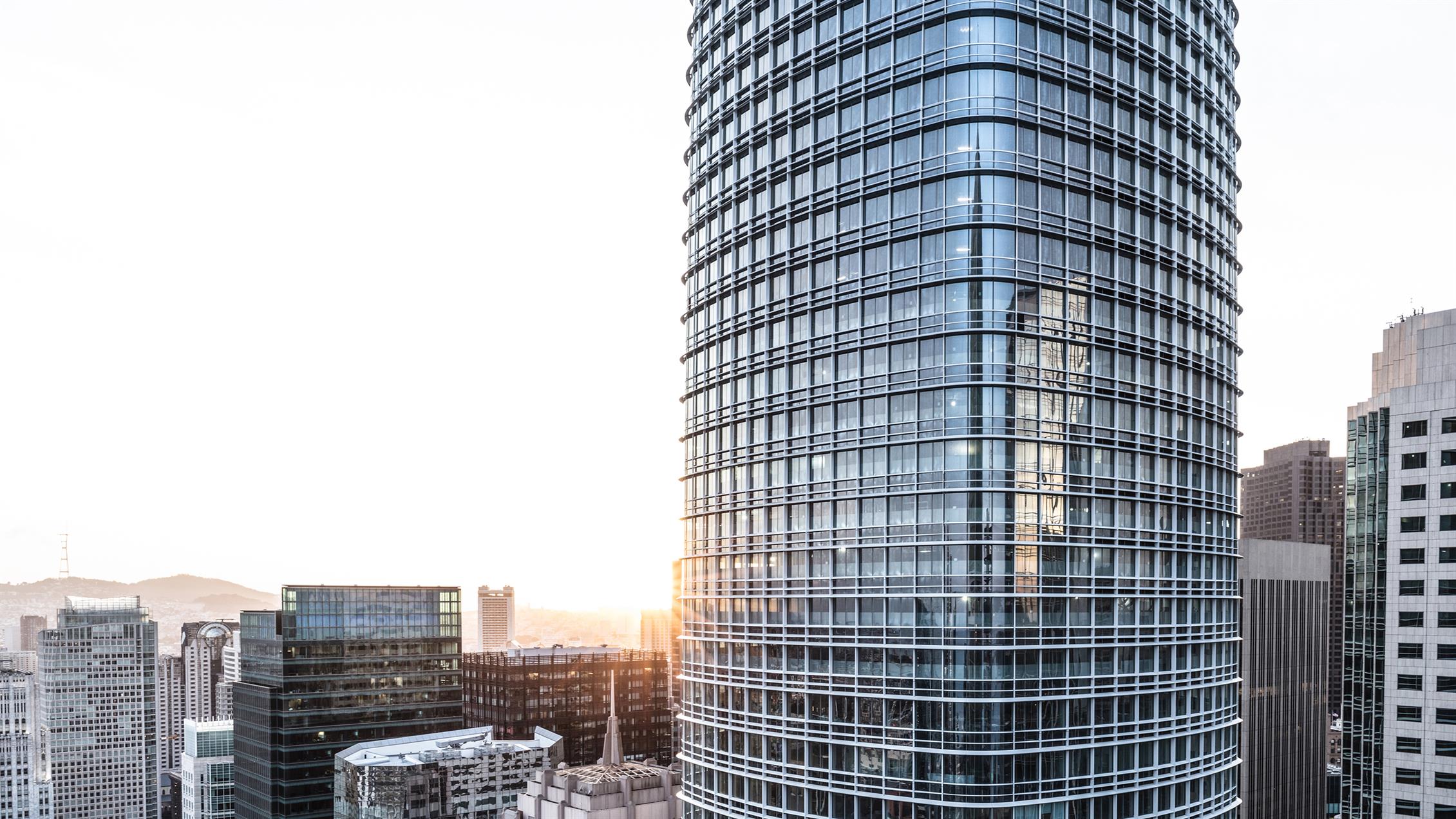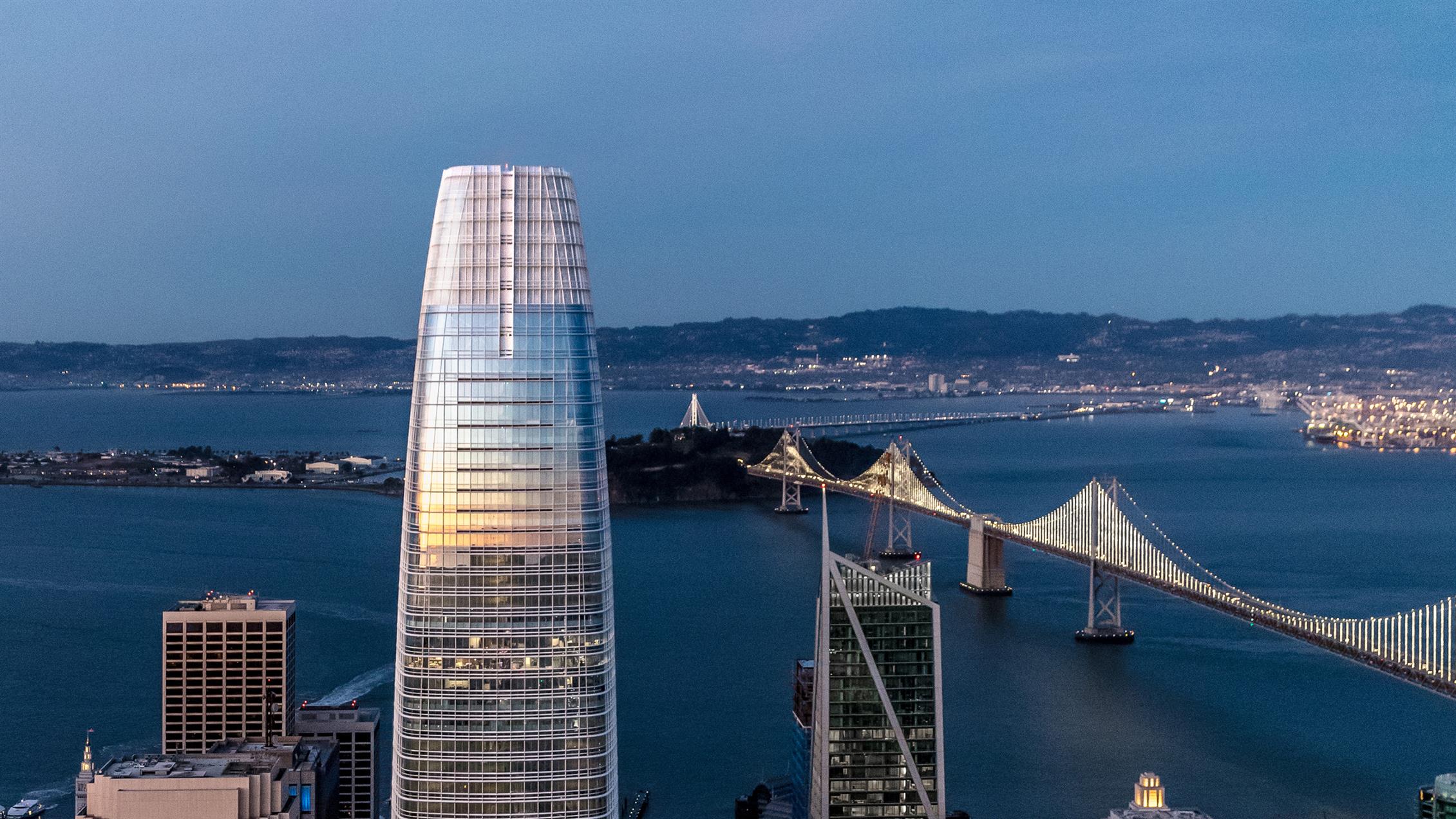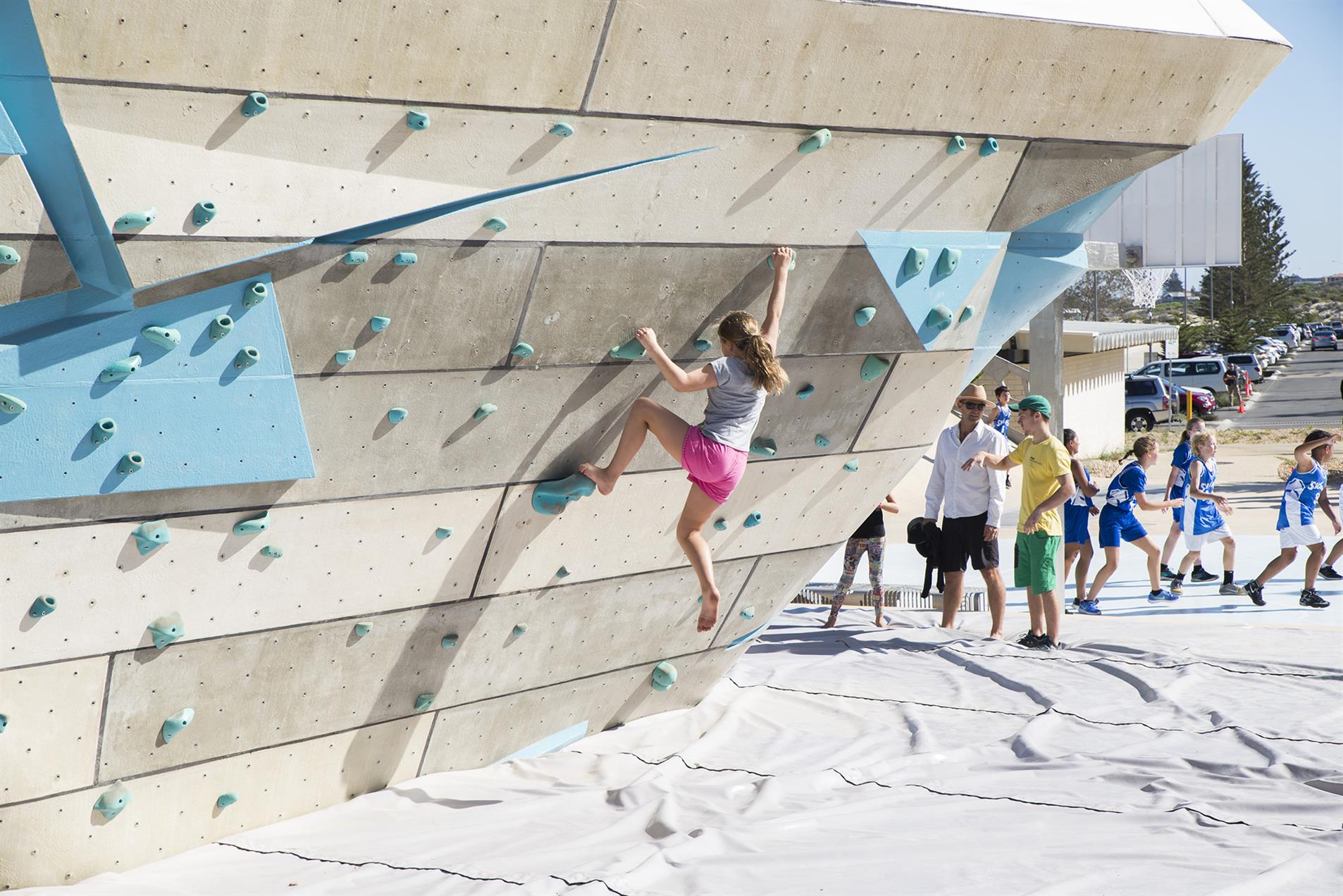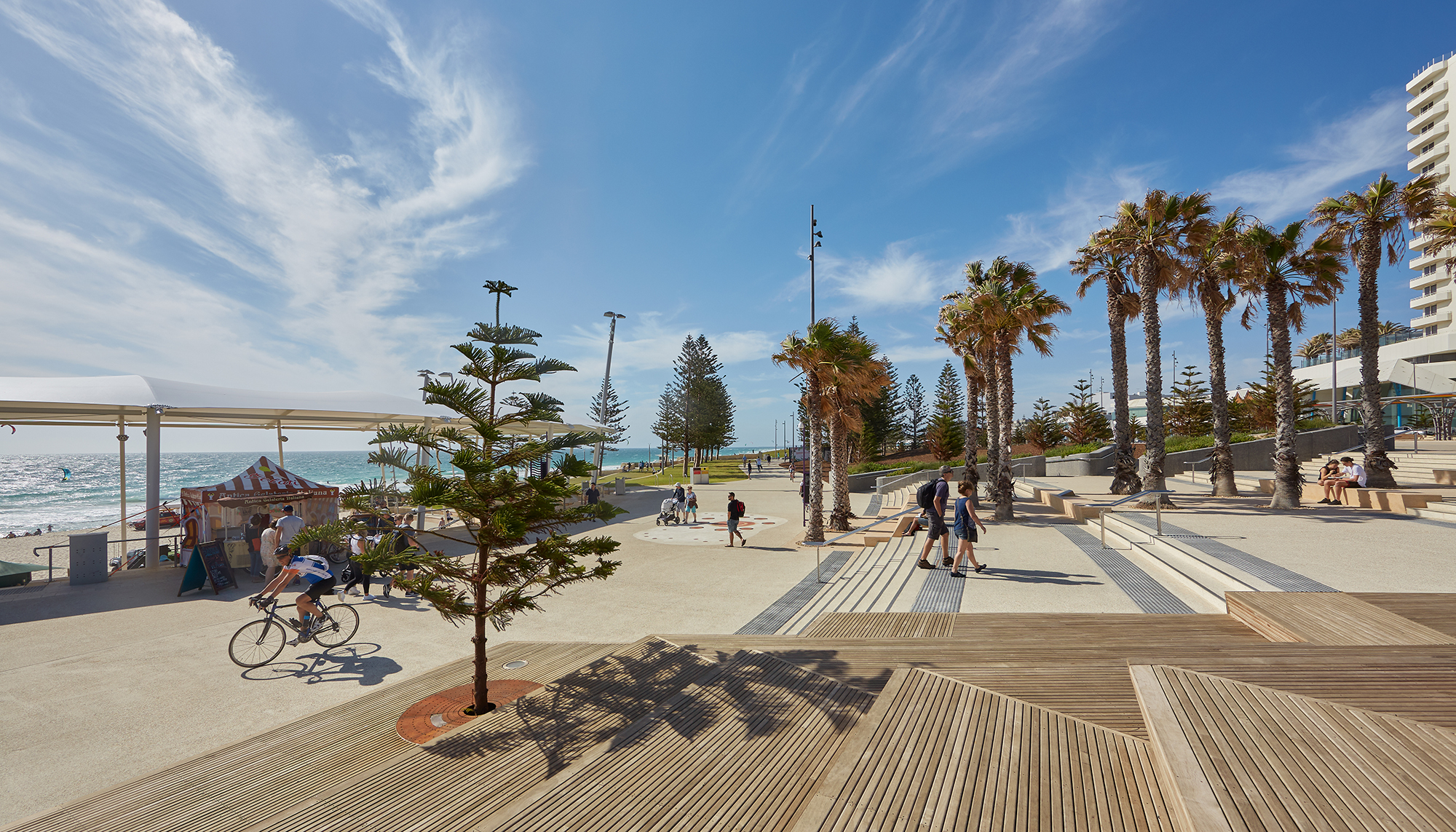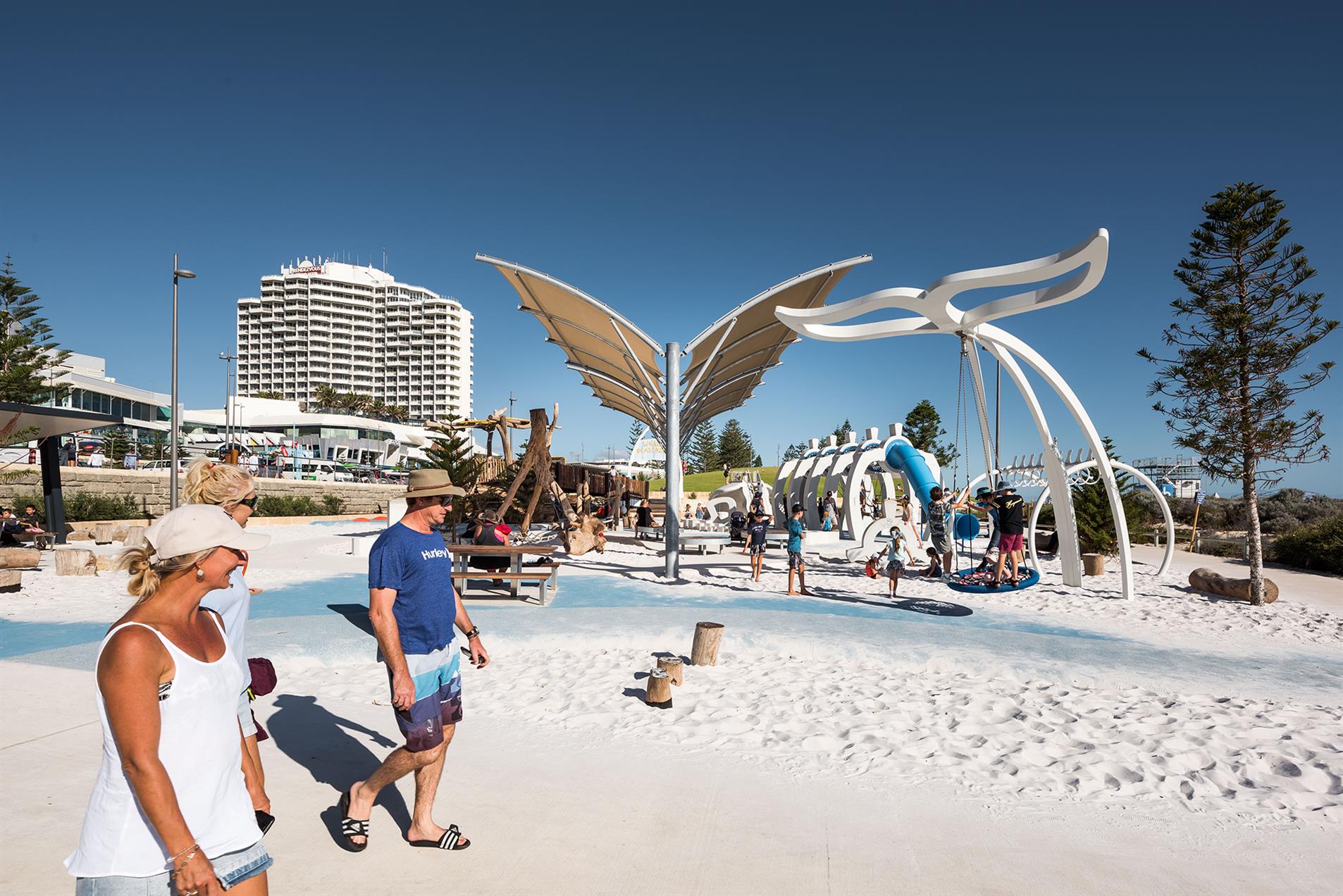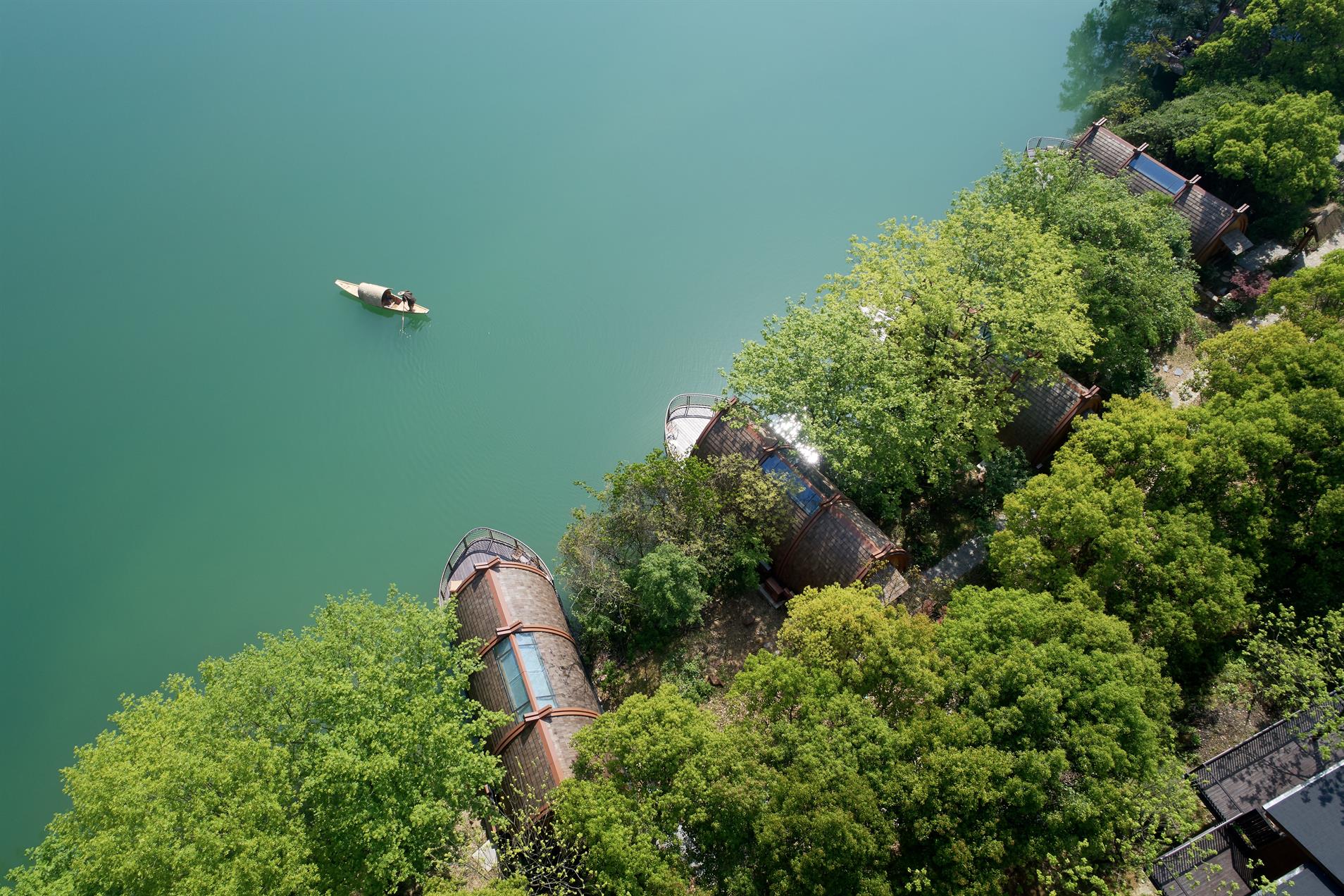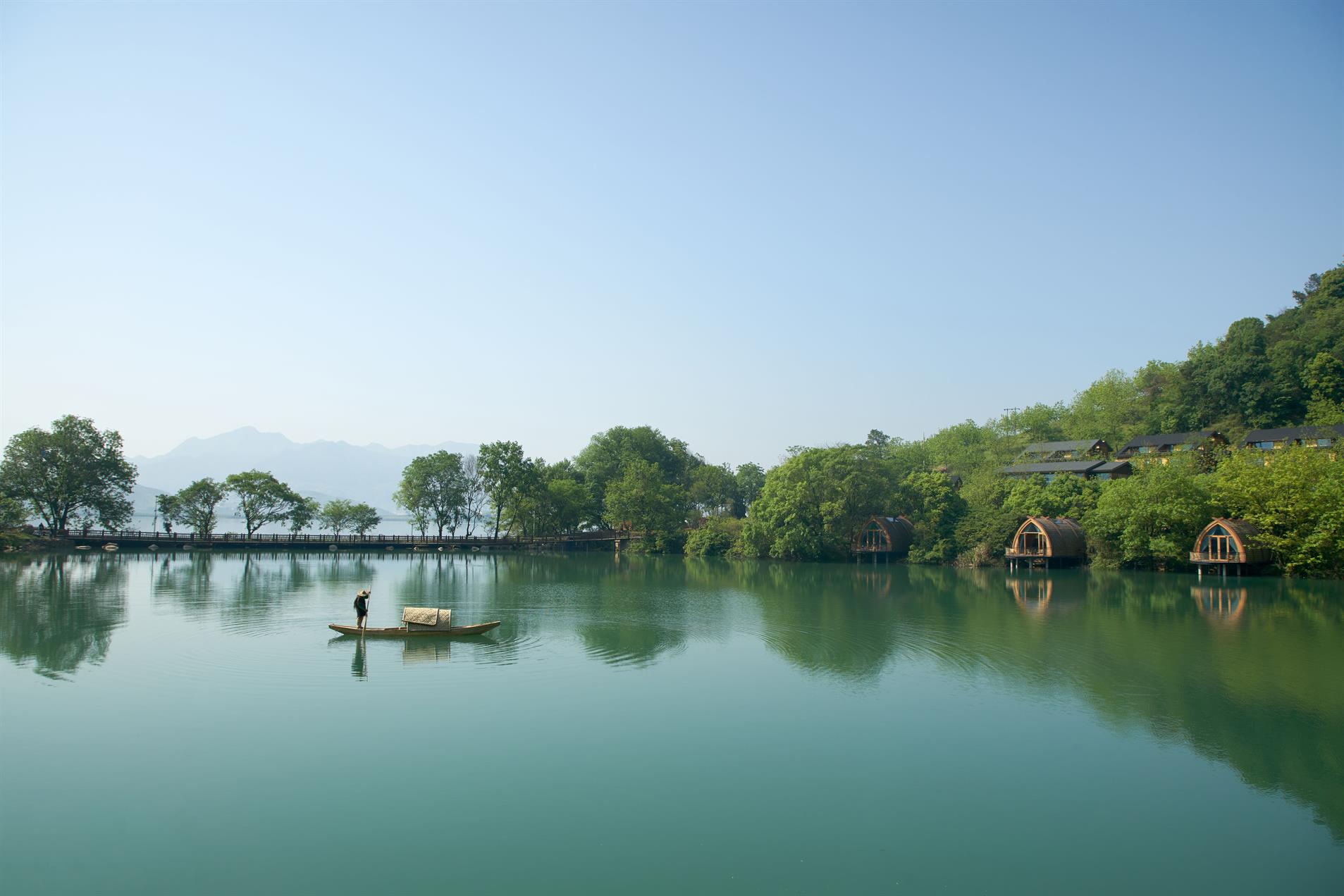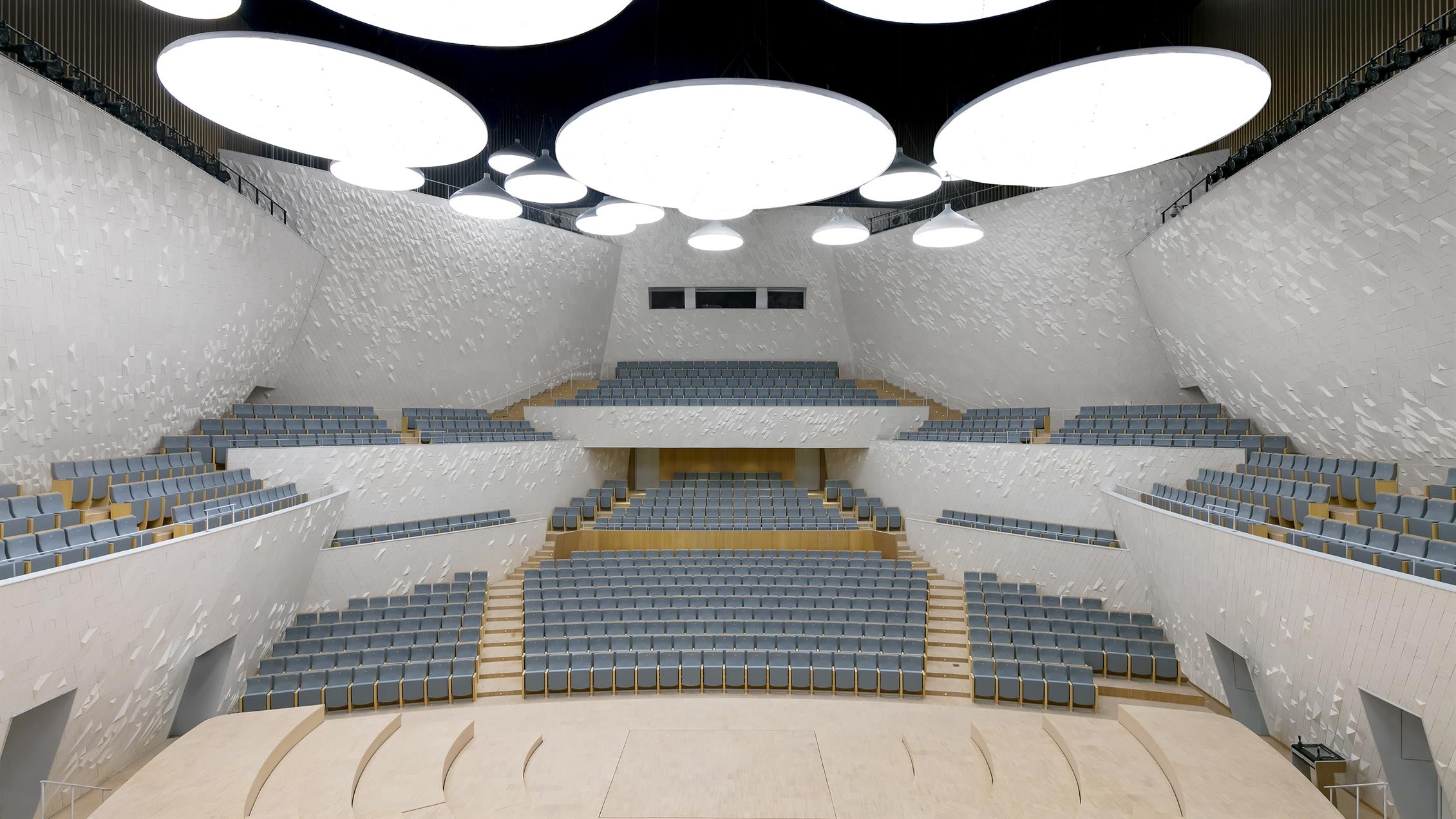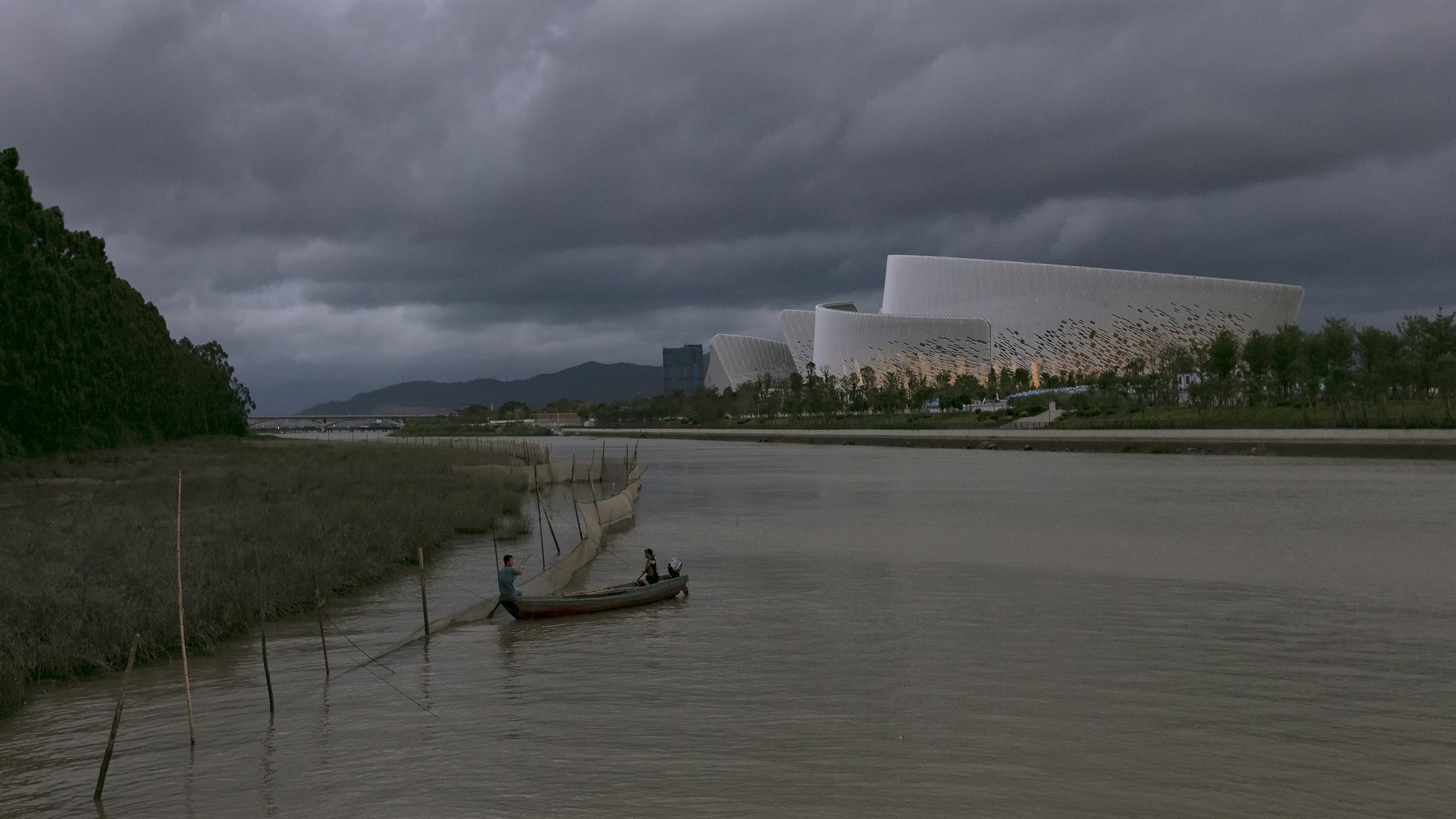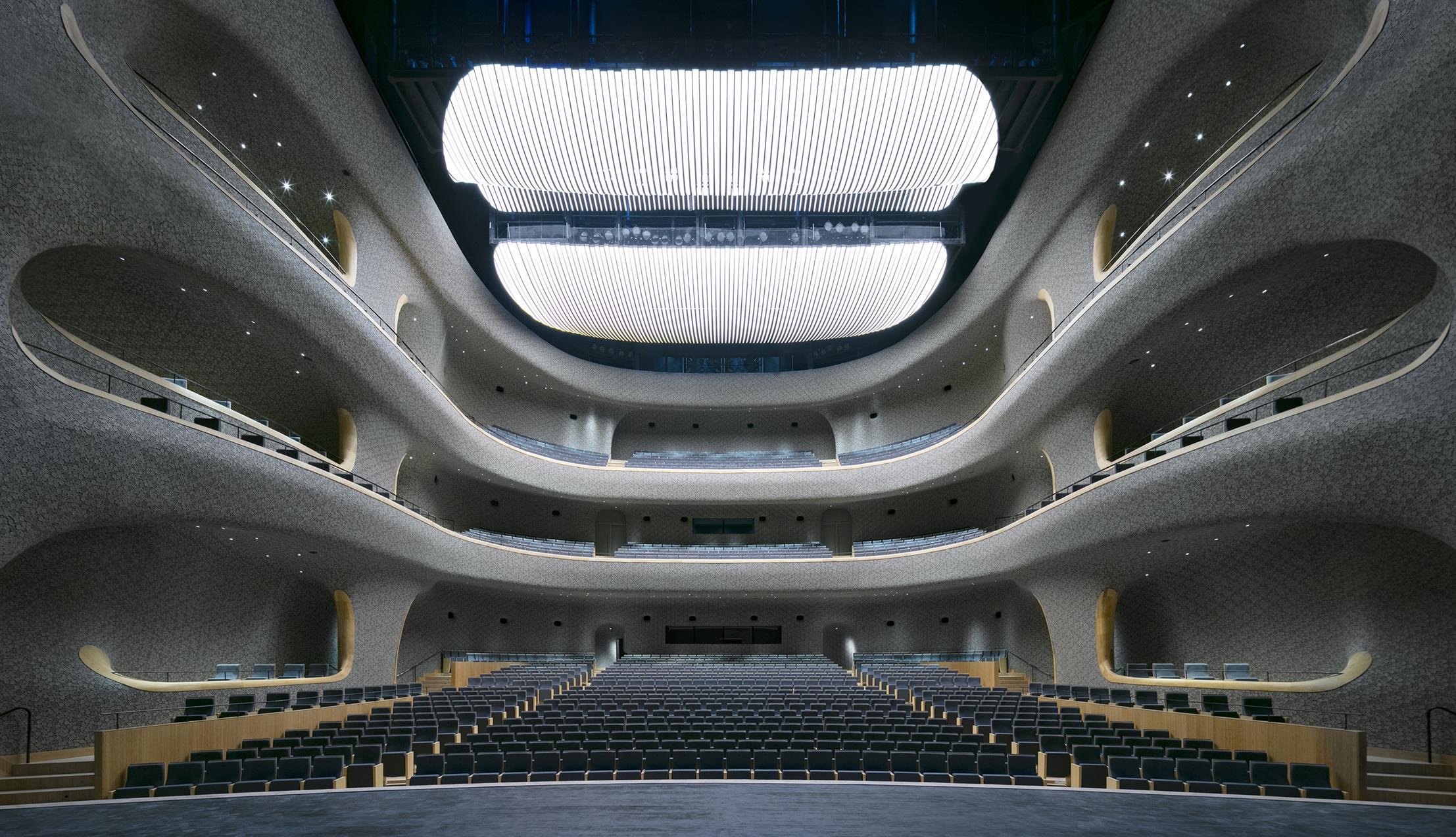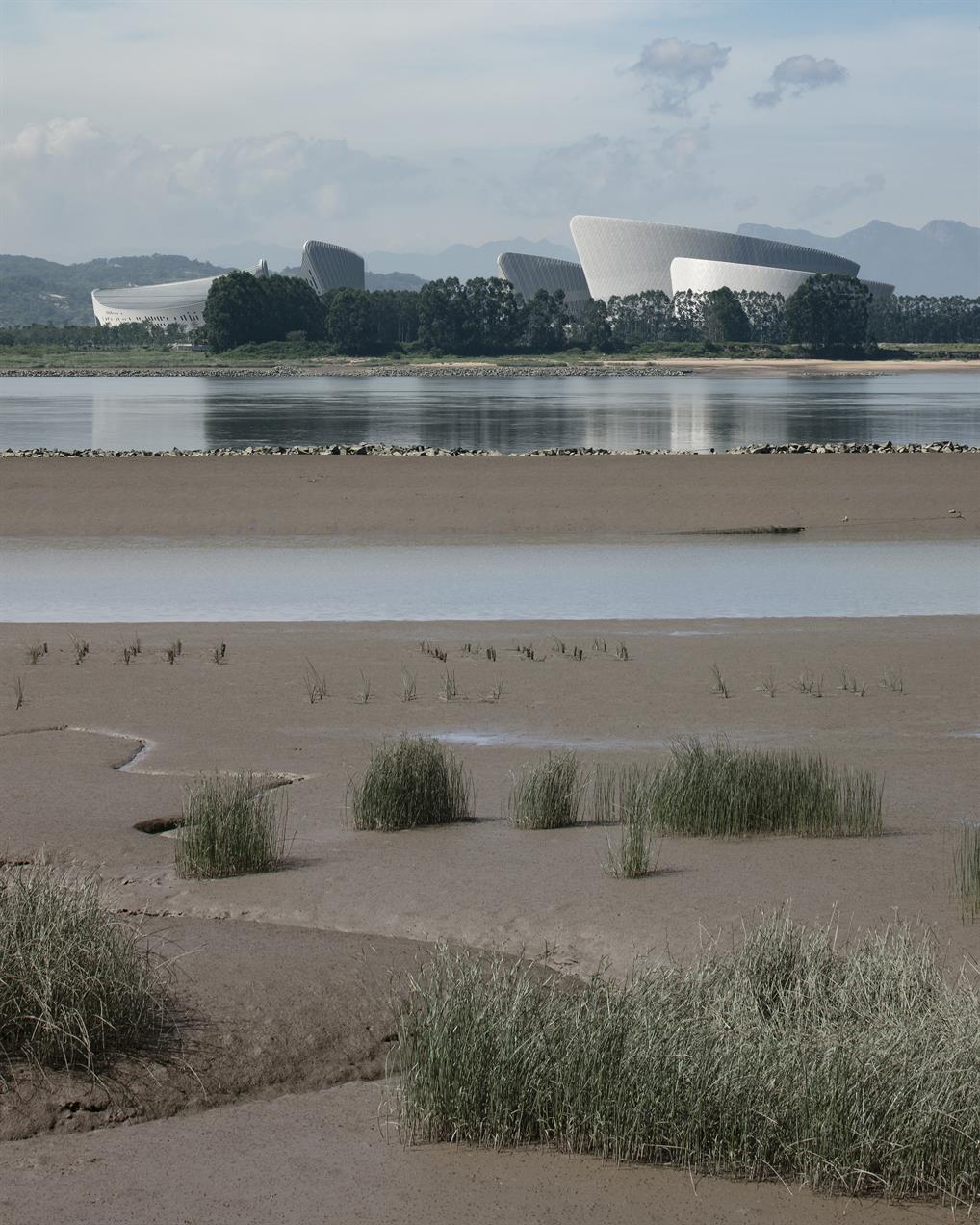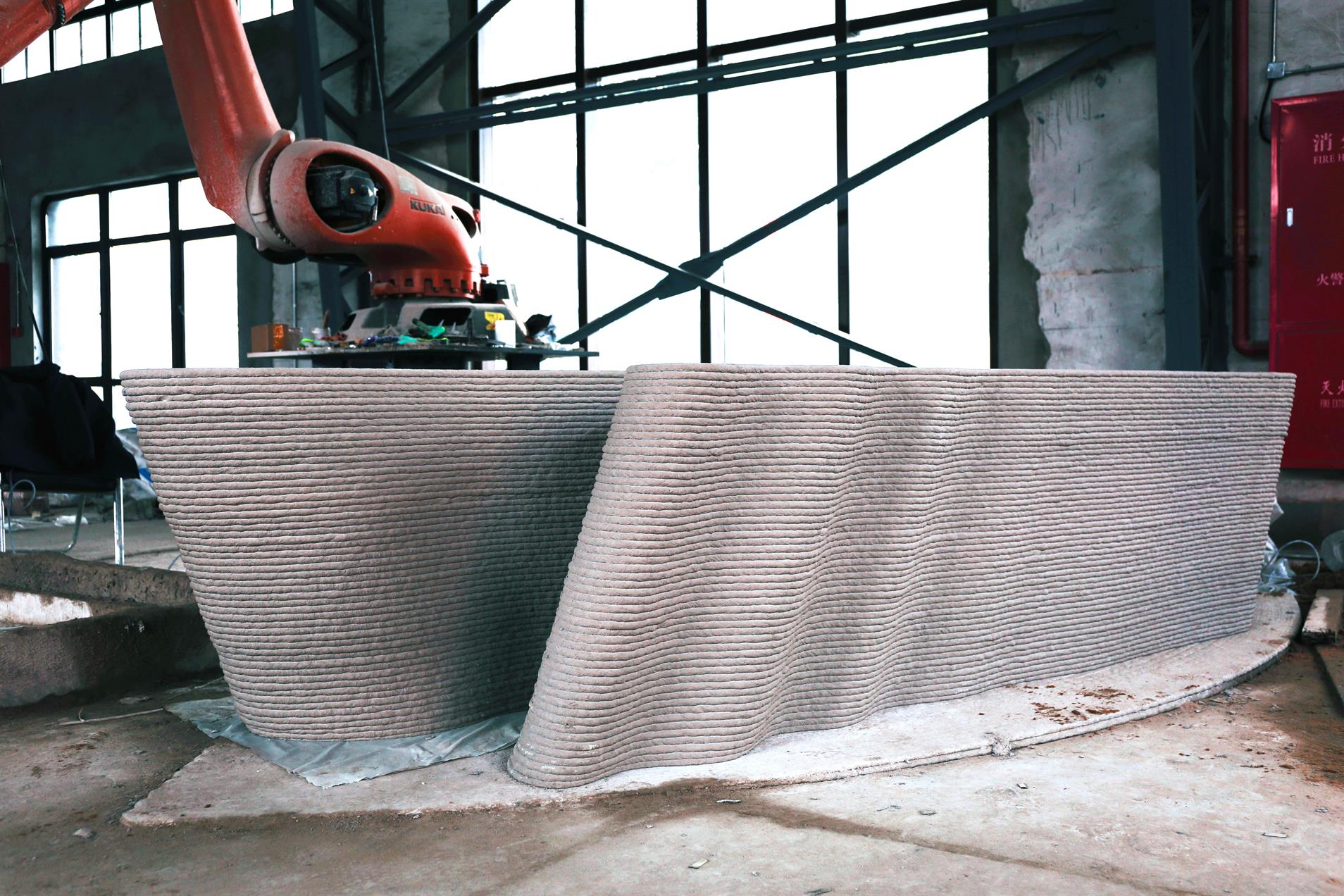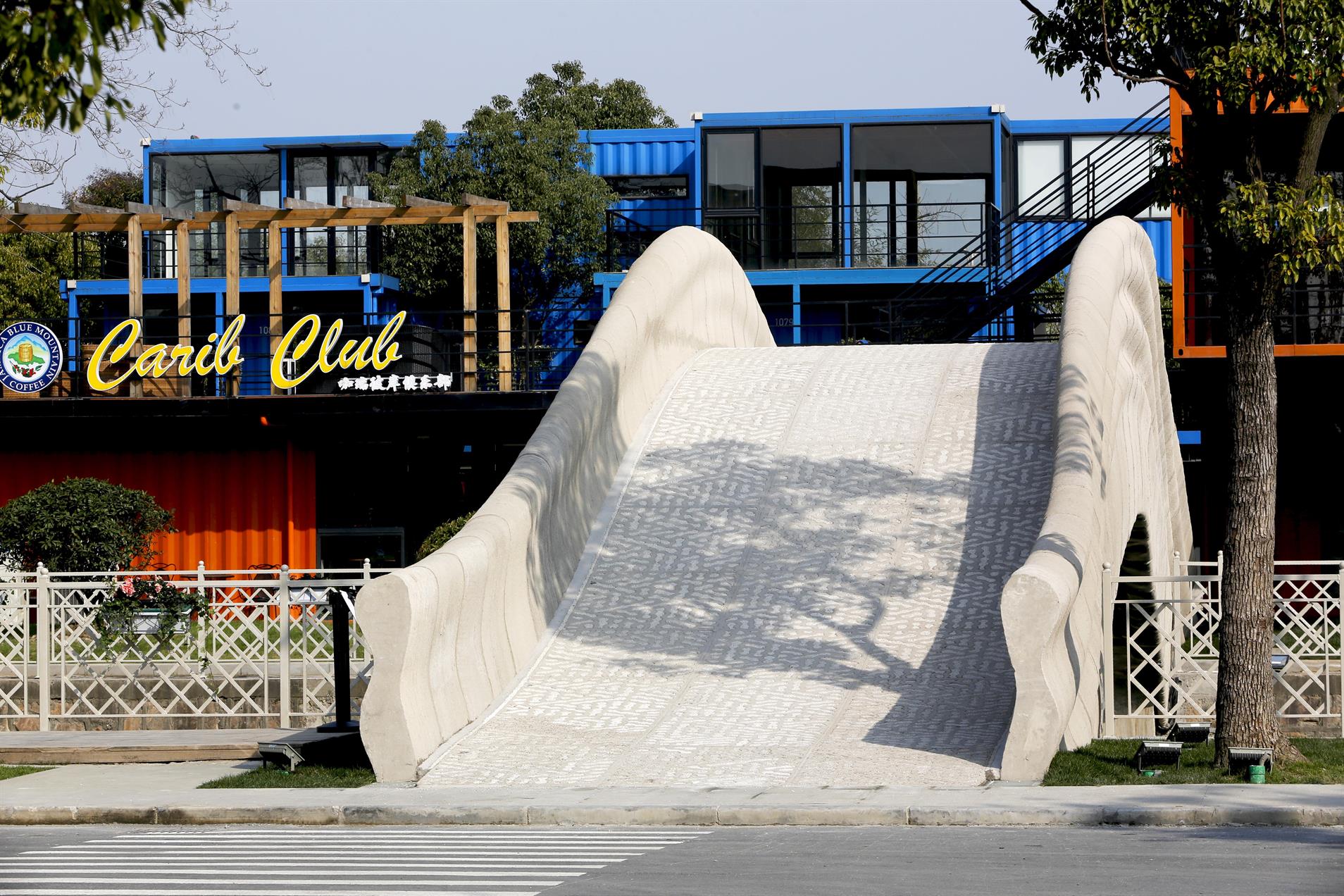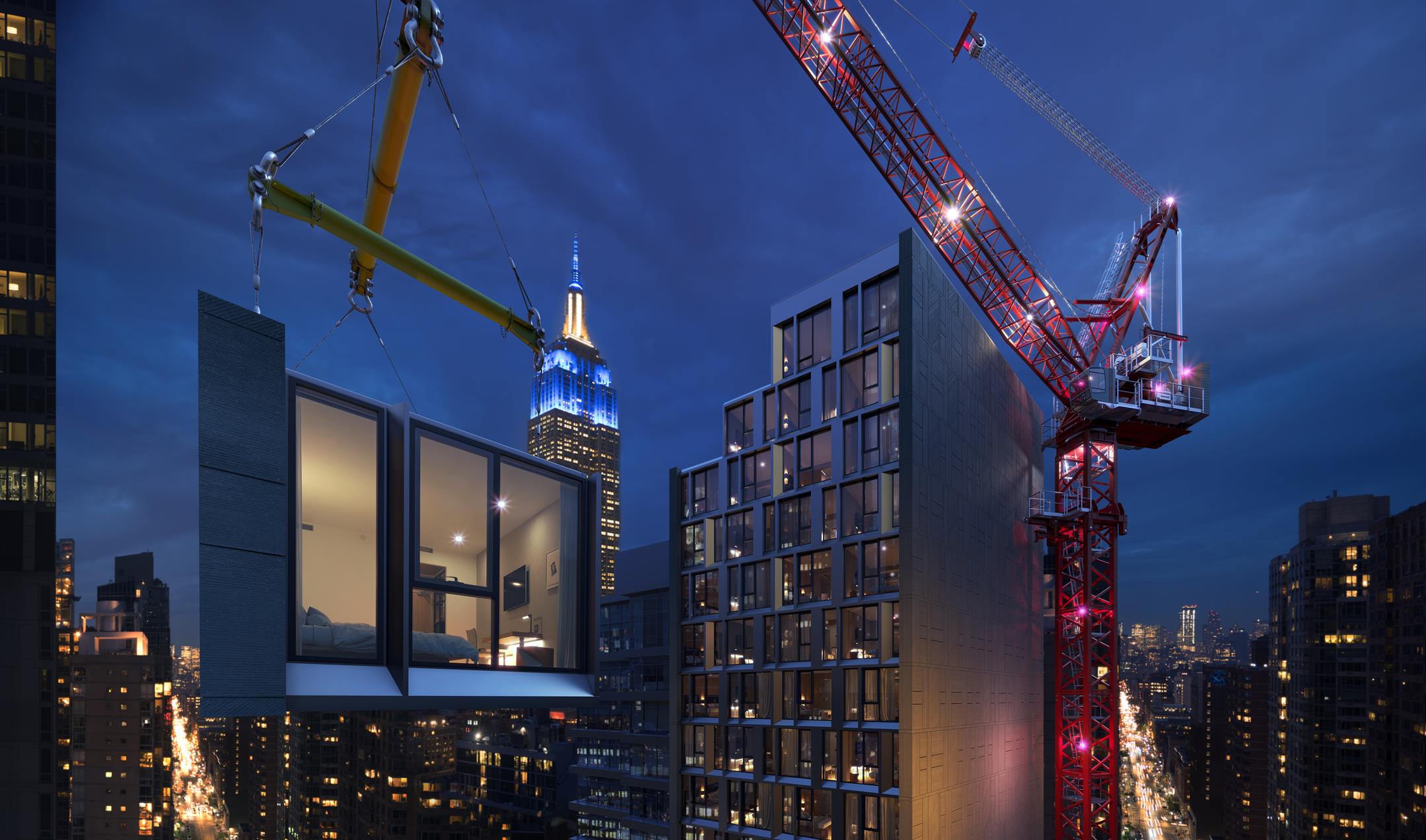Adaptive Reuse
Gold: Persian Garden Studio, Hanna Boutique Hotel
Around 90 years ago, six buildings were constructed in the center of Tehran, creating its one and only symmetrical street. Hanna project, which includes a hotel, restaurant, gallery, and multipurpose spaces, was designed in one of these buildings, with the intention of bringing life back to Lolagar Alley and Tehran’s city center.
Part of the design intention was to reconnect the building to Lolagar Alley, the neighborhood and its residence. As such, new layers were added inviting users to move around and inside this historic building. With their simple forms and neutral colors, these new volumes accommodate some of the building’s new functions; garden, recessed courtyard, part of the restaurant, and gallery. An added neutral volume on the east elevation is used to house the bathrooms for the hotel, and rises to the roof to create the hotel’s special suite which provides a panoramic view of the surrounding areas. On the building’s façade, steel frames were added to define the gallery’s entrance and also to provide more light and views to the hotel guests.
Because the building was left unoccupied over the years, there was much damage to its structure, which made its structural reinforcement quite complex. The concrete slabs serve a structural purpose and are also the finished interior flooring. The juxtaposition of new and old layers presents its occupants with the building’s history. Shear walls and steel structures are also left exposed to familiarize the building’s visitors with its renovation process.
Silver: Studio A+, Bapan Yard No.2
Revitalization of antique architecture in the countryside is critical in a fast-developing country like modern China. In the past 10 years, fast-built universal concrete houses emerged rapidly, occupying the once picturesque countryside. While this type of architecture is economic, and easy, it lacks characters and intrudes the harmonic landscape. Nowhere is this more evident than the Bapan village in Guizhou Province in southern China, the home of the Bouyei (Buyi) people who are one of the oldest ethnic people in China. Bapan village is abundant with unique ancient culture. The seniors preserve the lifestyle and traditions dating back hundreds of years since the Ming Dynasty (1368-1644). They live in houses built with authentic elements using ancient techniques of the region. Therefore, the recent concrete houses pose a bizarre conflict to the vernacular architecture and its environment. How could architecture adapt? Bapan village calls reconsideration of ways to inherit its cultural values.
Through rigorous analysis and engagement with the local community, a site-specific, environmentally just proposal provides the opportunity to redefine the social and cultural qualities of the Bapan village. This proposal strives to rescue and revitalize the deteriorating antique house at Bapan Yard No.2 with minimal intervention. Through remodeling the space, repurposing on-site materials, replace decayed parts and replenish its ever-present spirit and energy, the design is intended to be light-handed, environmentally sound and affordable. This is a pioneer project of a series of Bapan poverty alleviation projects and a prototype of reconciling traditions and modernity through architecture.
Bronze: Zhang Hua Studio, Tianjin University Research Institute of Architectural Design & Urban Planning, Millet Vinegar Museum
The shape of the ancient history of vinegar and jars, cans and other containers gave the designer the initial design inspiration. The overall shape of the building is a simple cube. The texture of the building facade is like a geological fault section, making the building grow out of the ground, while the grooves on the vertical surface are the marks of the buried ancient containers printed on the cube.
The facade is decorated with concrete slabs made from waste materials. The Ammann tiling method not only reduces the construction difficulty, but also makes the splicing effect random and natural.
Crack is a kind of embodiment of the vitality of nature, everywhere, cracked soil, plant veins, animal fur, and cell structure is composed of crack, ancient Chinese porcelain is also like to burn on the surface of the texture of crack. We also used this texture in the details of the building to express the integration of the building and the land.
In the interior design of the building, the design concept of the utensils is also reflected everywhere. The “urn” recessed at the entrance forms a natural rain shed, which also forms a “visual focus” on the facade. Subsequently, the semi-spherical hall brings people into the wonderful space experience.
Light shines through the dome into the interior, and the resulting shadow presents in the shapes of vinegar urn. As the time changes, the resulting shadow varies in different shapes of vinegar urn, reflecting the exquisite design idea.
Colour in Architecture
Gold: SUP Atelier, Indoor Playground (Doubling as lecture hall) of Yueyang County No.3 Middle School
The project is located in Yueyang county, Hunan, China. In celebration of the 60th anniversary of Yueyang County No.3 Middle School, the client decided to sponsor a new indoor playground doubling as a lecture hall with the purpose of creating better sports space and invigorating the regularly planned campus.
The newly-built indoor playground lies at the southwest corner of the campus, where there’s an altitude difference between the main teaching area and the outdoor playground. Instead of sitting simply at either side, the building stretches across the altitude difference, thus forming a natural link between the teaching area and the playground. The activity space, which lies at the lower side can be accessed from the front square through the curved steps, which can serve as grandstands when needed.
Natural ventilation and lighting serve as major sustainable strategies to improve thermal comfort and reduce the cost of equipment and maintenance. The integration design approach takes form, space and sustainable strategies into consideration simultaneously.
Cast-in-situ methods and prefabrications have been both applied in the construction to alleviate the impact on the campus. The neat work of red bricks, with characteristics of artisan craftsmanship, is designed integrally with industrial building parts, offsetting the monotony of an industrialized building with its sense of artistry and freedom. The color and pattern of the main building resembles the abstraction of Yueyang’s topography, as well as the distribution of its mountains and waters, providing students with more fun and interaction through the power of design.
Silver: Takenaka Corporation, Kakogawa Kindergarten
We aimed to reinterpret spatial quality of a forest in the kindergarten. Our client runs various types of schools from kindergarten to university and they are challenging to make a cultural focal point of the local community by opening their academic environment to the town. We answered them with a porous open air building connected to its surroundings. Rooms are scattered through careful study in interaction with the environment. By blurring edge and combining various colors and materials, the building obtains an ambiguous openness and continuity to the environment. Users are strolling around and enjoying light and wind as if they are in a forest. Children are getting active and develop their curiosity and motivation to learn. Colour plays important roles in the architecture from both sides; interior and exterior. Each colors characterize living space of children and it raises imageability and attachment to individual places. Also, colours are expressing the lively active atmosphere of the building to the town, and the number of visitors have actually increased after the completion of the project. Each colour in this building are chosen from flowers in their surrounding environment. It reflects the traditional Japanese colour palette which are often named after indigenous plants and animals.
Bronze: Yuan Lih Construction Co., One Park Taipei
Cutting a bold figure of orange, melon yellow and its exterior titanium-zinc plate, One Park Taipei stands tall in the center of Taipei, breathing new life into the cityscape of Taipei, and setting a new benchmark for Taiwan's high-rise residential projects, original ideas and design concepts, especially in their use of bright colours.
Acting as pavilions in the landscape, the design has set a new benchmark in high-rise residential projects in Taiwan, in terms of location, views and aspect, spatial quality, landscape design and public amenities.
The apartments are elevated above a 12m tall entrance lobby to give uninterrupted west-facing views over an adjacent elevated road and towards the popular Da’an Park. Each floor is flexible and can be used as a single apartment of around 600sqm, or can be divided in half to create two smaller units of approximately 330sqm each. All apartments have panoramic views of the park from generous external terraces, while residents have access to a rooftop terrace. The larger apartments come with double height terraces. Whilst the park elevations are articulated by external terraces, the north and south elevations are articulated by projecting windows and external shading elements. The east elevation alternatively offers unique city views of Taipei CBD and the iconic Taipei 101 tower.
Facade
Gold: System Architects, Unhistoric Townhouse
A city’s life is in its streets. It’s where we move, connect, watch and listen, love and learn. While our homes are a refuge from the chaos of the streets, we still want to be part of the pulsing public life.
The project is a five-story townhouse, built for a family. But the building is only one room deep, and the widest dimension of its footprint is on the street.
We embraced the site’s intimate involvement with the street as a central theme of the project: to create a façade that engages the rhythms of the neighborhood and enfolds the family within, protecting them from the street while bringing in its energy and light.
The complex geometry of the interior is mirrored in the twists and folds of our façade, which gives passersby a glimpse of the interior domesticity, dissolving the wall between the home and street, while at the same time offering a vibrant new element to the neighborhood.
The radical twists and folds are all accomplished with standard-sized bricks, materials characteristic of the historic neighborhood. To accomplish this, we devised a groundbreaking, cost-effective computational technique, creating a life-sized template for traditional skills. The steel frame that holds the new facade in place was so precisely prefabricated that it was delivered by crane and installed in just one day.
The result is a remarkable new type of building, one deeply rooted in the street life of the historic neighborhood, which also signals that a new era has arrived.
Silver: PES-Architects, Fuzhou Strait Culture and Art Centre
The building shapes remind of ships in a harbor, referring to the ancient maritime silk-road history of Fuzhou.
Ceramic material is used in different innovative ways in several key areas throughout the building design, strongly linked to the overall concept of the project, based on the location by the Taiwan Strait and, historically, in the context of the Maritime Silk Road trade connection between China and the rest of the world.
The ceramic screens of the main façade are made of 42,250 ceramic louvres, covered with white glazing and featuring a lens shaped section, related to the form language used in the building, but also to maximize the shading capacity of the façade. Complex scripting tools were applied to determine the optimal angle and distance between the louvres. The roof is clad with pre-patinated zinc.
The overall geometrical pattern was created using a second custom-developed script, coping with the double-curvature façade surface. While the distance of the straight main steel columns increases towards the top, diagonal (double-curved) secondary pipes are arrayed so that their center to center distance is exactly 1,80m over the whole façade surface, enabling the coverage of the entire façade geometry with only one single ceramic louver element.
During the evening time, the interior bamboo wall creates a deep secondary façade layer behind the white ceramic screen.
Besides cooling the entire building with river water, the shading exterior ceramic façade has been utilized as one of the main passive design measures for energy saving in the project.
Bronze: Marcy Wong Donn Logan Architects, Center Street Parking Garage
The City of Berkeley's Downtown Arts District has blossomed into a popular destination for locals and visitors alike. People arrive by public transportation, bike or car to frequent bars, shops and restaurants, or attend events. The original 1950s’ garage was not only insufficient in parking-capacity, but was woefully below current seismic safety standards. This architectural sleight-of-hand is a visual feat in response to a challenging brief: create a behemoth eight story, 720-car parking garage on a tight mid-block site, while providing a creative facade fitting of its artistic context.
Also housing retail, art, public restrooms, bicycle parking, a cafe, and offices, the mid-block site provides opportunity for two street-frontages, the facades of which are designed as public-art. A perforated aluminum security-screen forms horizontal bands that contract and then flare—two massive waves, each surging in a different direction, every panel adding its own small syncopation. When daylight slices through, small dots dance against thick concrete; and at night, choreographed lighting washes the pleated metal scrim in an ever-changing array of colors. Its colorful, cantilevered, open-air staircases are the antithesis of archetypal grim, isolating garage circulation—in full-view of the public, they feel thoroughly safe, with expansive views.
The layering of the concrete structural core, steel exterior framing, and dynamically lit metal scrim creates an integrated solution—definitely a place for cars, but with a face to delight people. Berkeley’s transportation manager, Farid Javandel, told news organization Berkeleyside: “From commuters, I've been hearing it is the best-looking new building in downtown Berkeley.
Small Spaces
Gold: West-line Studio, Danxia World Heritage Gateway
The tourist rest spot welcomes to the core scenic spot of the UNESCO World Natural Heritage site in Chishui region, northern Guizhou province, a popular tourist attraction characterized by stunning red cliffs, peaks and streams.
The building design is sensitive to the characteristics of the landscape and the local Danxia red stone makes it completely embedded into the surroundings. Materials come from river flooding: the project is located at the base of a mountain, from which the top originates a river. When torrential floods erupt, various sizes of Danxia stones are transported downstream by the river, collected by workers and easily cut thanks to their high-porosity.
The tourist rest spot is located in a V-shaped canyon, 6m width at its narrowest point. On the northern side a twisted corridor responds to the stream’s dynamics. The building on the southern side is the most important: it is composed by a group of seven little stone boxes, which are characterized by a rainwater collecting system, light capture system and tree courtyards. The stone boxes include facilities like tourist reception hall, exhibition hall and tea hall, where local spring water is used to prepare the tea.
The project aims to abstract the site characteristic features: the forest is symbolized by a dense assembly of stone pillars, the mountain by the undulating roof, while the relationship with water is brought into the project by a rainwater collection system. The colored light system, together with water and trees courtyards, aim to create a ritual space.
Silver: SUP Atelier, Swirling Cloud: Bulletin Pavilion for BJFU Garden Festival
Inspired by this famous verse in an ancient Chinese poem: “A gale has risen and is sweeping the clouds across the sky”, the design team has presented a “pavilion of swirling clouds” for the garden festival of BJFU.
Covering an area of 120sqm, the pavilion will serve as a hub for information during the festival, and turn into a place for recreation and gathering after the event.
The design approach has taken full advantage of bamboo’s features, especially its malleability and bending resistance. The positions of curved openings on the pavilion were determined by the flow of people and the distribution of trees, bushes and stones on the site, so that people can easily walk across the square through the pavilion.
The pavilion stretches over the bushes in a light and graceful way. The top of the pavilion narrowed into a round skylight, merging the building with wind, sunlight and green plants, while presenting an image of swirling clouds.
With the help of the long-standing processing techniques of natural bamboo, the size, shape, structural from and details were confirmed through close collaboration of architects, structural engineers and bamboo contractors. Modern building techniques, digital design technology and bamboo construction were integrated through pre-fabrication.
Through close collaboration, the architects and the bamboo contractors have discovered a practical prototype that can adapt to various site conditions and functions thanks to the great flexibility of bamboo design.
Bronze: Mozhao Architects, Living Art Pavilion
The Living Art Pavilion is located in an industrial park of Shajing, Shenzhen. Combining functions of culture and amusement, it is the highlight of the industrial park’s upgrading strategy. The Pavilion faces the expressway in the north, with a row of Terminalia mantaly retained right outside the wall at the north. The walls in this direction were specially designed at different heights, which not only lowered the impact of noises from the north, but also formed a beautiful scenery with the Terminalia mantaly outside. To the south of the building is Office Building No. 2. The pavilion, together with the commercial and artistic spaces on the ground floor, creates a multifunctional space. With profiles and interfaces of different building interacting with each other, a comfortable and pleasant public space for pedestrians were created.
The whole building is composed of six unit blocks. The independent furniture store is composed of four unit blocks in the west, while the two unit blocks near the plaza entrance acts as an amusement bar. Prototype of Living Art Pavilion are referring to traditional dwellings elements: sloping roof and courtyard space.
The concrete rib beams structure enhanced the aerial perspective effect of the sloping roof, which copied the texture of a pine. Walls and openings are distributed only in the north-south direction of each unit, which created a sense of order and a feeling of depth in the east-west direction. Courtyard space of adjacent units is arranged in the south or north alternatively.
Sustainable Buildings
Gold: gh3 Architecture, Borden Park Natural Swimming Pool
The Borden Park Natural Swimming Pool is the first chemical-free public outdoor pool to be built in Canada. The project replaced an existing pool, and includes a seasonal pavilion and landscaped pool precinct for 400 swimmers.
The challenge was to create a large-scale pool with high-quality water control while also achieving an environmentally healthy and natural filtration process. The design process began with developing a pool technology that cleanses the water through stone, gravel, sand, and botanic filtering processes. This inspired a materials-oriented concept for the change room facility to achieve a technically rigorous and aesthetically integrated design whose gabion basket stone walls visually evokes the idea of filtration.
The pool involves a balanced ecosystem where plant materials, microorganisms, and nutrients come together within a gravel and sand filtering process to create “living water.” Filtration is achieved in two ways: through a biological-mechanical system or the constructed wetland and gravel filter, and in situ, with Zooplankton.
The seasonal building houses universal change rooms, showers, wash- rooms, staff areas and the water filtration mechanisms. The swimming program includes a children’s pool, a deep pool, on-deck outdoor showers, a sandy beach, picnic areas, and spaces for other pool related recreational activities.
The project’s materiality creates a fundamental conceptual connection between the technical demands of the pool and the design of the built enclosure and landscape elements. The elemental form and reductive materials ease the user experience and enriches the narrative of bathing in the landscape.
Silver: Stantec Architecture, University of Northern British Columbia Wood Innovation Research Laboratory
The University of Northern British Columbia (UNBC) Wood Innovation Research Laboratory (WIRL) is designed to enhance the capabilities of the students, faculty, and researchers from UNBC’s Master of Engineering in Integrated Wood Design program. The building houses a specially constructed strong wall and floor designed for state-of-the-art seismic testing of wood products. The considerable ceiling heights allow large sections of building materials to be assembled, moved by overhead crane, loaded and unloaded onto delivery vehicles, and carried to the testing area. The building served as a learning and teaching tool for UNBC during and after construction.
The design is a modest building influenced by passive design principles and the innovative use of wood products. It responds to and compliments its surrounding buildings forms and orients itself in response to the urban landscape. The dark metal panel exterior wraps a warm wood interior with exposed wood structure on the interior.
This is the first Passive House certified building in Canada for an education client. This presented a challenge due to the subarctic temperatures typical of Prince George, and the design of walls and roofs required careful planning. The completed construction set a new standard for airtightness, securing the best North American result of any building under Passive House standard. The testing protocol involves both pressurizing and depressurizing the building and measuring the number of air changes per hour that result. With a score of 0.07, WIRL surpassed the Passive House requirement by nearly a factor of 10.
Tall Buildings
Gold: b720 Fermín Vázquez Architects, Forma ITAIM tower
The apartments tower is located in Itaim Bibi in São Paulo, a neighbourhood in a deep transformation, which is moving from the traditional fabric of horizontal single-family homes to a skyline of buildings in height, mainly homes that meet a growing residential demand for a prosperous upper middle class in the economic capital of the country.
The tower, highly conditioned by the volumetric limitations imposed by the regulations and the strict requirements of functional optimization, hosts small houses with large individual terraces. The project seeks to maximize the slenderness of the volume and highlight, without stridency, in the monotonous sea of undifferentiated skyscrapers of São Paulo as a “singularity of good manners”.
The floors are articulated in two parallel bays and a central communications core that includes two batteries of panoramic elevators. The main openings of the houses are oriented to north and south, with deep balconies to mitigate the intense Brazilian solar radiation, while the east and west facades, the most exposed in the climate of São Paulo, are solved with a predominance of opaque protected surface by a ventilated façade of large-format glazed ceramic pieces.
On the balconies sides, the ceramic coating becomes lattices which preserves the houses privacy and frame the views from the inside. The combination of colours of the covering pieces seeks the chromatic individualization of each level, as well as the research of singularity that provides the differential qualitative value sought out by the client, who specifically wanted a colourful tower.
Silver: Pelli Clarke Pelli Architects, Salesforce Tower
Salesforce Tower is the tallest building in San Francisco, joining the Golden Gate Bridge and the Transamerica Building as one of the skyline’s defining elements. Standing 326 meters tall, the tower has the simple, timeless form of the obelisk, giving the 61-story tower a slender, tapering silhouette. The walls are composed of clear glass with pearlescent metal accents. These horizontal and vertical accents gradually taper in depth to accentuate the curved glass corners. The walls rise past the top floor to form a transparent crown that appears to dissolve into the sky. Carved into the tower top is a vertical facet that is lit at night.
At its base, Salesforce Tower connects directly to the Salesforce Transit Center, which will house 11 Bay Area transit systems. On top of the transit center and linked directly to the tower is a 5.4-acre public park, which will offer recreational, educational, and nature activities. The park has two roles: the future anchor of the neighborhood and a key element of the project’s sustainable design strategy.
Certified LEED Platinum, each floor of the tower has integrated metal sunshades, calibrated to maximize light and views while reducing solar gain. High performance, low-emissivity glass also helps to reduce the building’s cooling load. Cooling is provided in part by heat-exchanging coils wrapped around the tower’s foundations. The tower also has the largest on-site recycling system in a commercial high-rise in the United States. High efficiency air-handlers take in fresh air on every floor.
Waterfront
Gold: TCL (Taylor Cullity Lethlean) with UDLA., Scarborough Foreshore Redevelopment
Where Perth meets the sparkling waters of the Indian Ocean, the Scarborough Beach precinct has long been a treasured beachside destination for locals and tourists alike. From an early morning surf to watching spectacular sunsets that farewells the Australian day, Scarborough is an established icon and expression of Western Australia urban beach culture.
To address the needs of a growing community, the public realm infrastructure was well overdue for an upgrade. What was the foreshore’s past expansive carpark culture is now required to provide a welcoming active experience for all ages. The challenge for the design team was to maintain the gritty urban ‘edginess’ of the historic precinct through this historically sensitive, yet significant transformation. Our team recognised from an early stage that this intervention will not be the last and therefore adopted a more fluid approach to dealing with the site’s spatial values and by adhering to an overarching principle: ‘It’s all about the beach.’
Two new promenades frame the waterfront, and within them spaces for recreation, relaxation, play and spectating have been created. Collaborations with Aboriginal artists enrich the design with place-specific narratives.
The transformation of the public realm from a carpark-dominated environment into a connected, activated and pedestrian-focused precinct has elevated the many qualities of this environment and cemented Scarborough’s national significance as a vibrant urban beachfront.
Silver: The Design Institute of Landscape & Architecture China Academy of Art Co., Boat Rooms on the Fuchun River
Far from the madding crowds and blanketed in nature, the bedrooms of these recently built, secluded retreats are the stuff dreams are made of. Concept and shape of the “Boat Rooms” take root in a local social custom, a water tribe namely “nine fishing families”, had resided at the riverside and created a unique culture of boat-living life between Ming Dynasty and the Qing.
Yanzhu Lake is the transition water area of Mountain Spring flowing into Fuchun River, meanwhile River water substitutes it in the dry season. The steady water level becomes a crucial factor for existence of Boat Rooms. Big challenges in the design refers to Boat Rooms’ docking without environmental interruption. Layout drawing of Boat Rooms fully respects the existence of trees. Prefabricated timber structures are assembled on site and the main body of Boat Rooms is supported by steel-pipe piles fixing on the bottom of the Lake, which avoiding of cofferdam construction and disturbing force with water system. Higher elevation makes the rooms ‘floating’ above the lake, displaying a graceful and quick-witted appearance.
As special rooms cluster in Fuchun New Century Wonderland Resort, domestic wastewater produced from the Boat Rooms flows into three artificial micro-ecological filters, eliminating sewage discharge to Fuchun River.
Design, construction and management of Boat Rooms make non-destructive approaches towards water system and lakeside environment. It verifies the best coordination of functional, ecological and artistic conceptions in five Boat Rooms and will be a sample in balance of architecture construction and water environment protection.
Bronze: PES-Architects, Fuzhou Strait Culture and Art Centre
Located in Mawei New Town, facing the Minjiang River, the Strait Culture and Arts Centre is about connections. It connects cities and communities along and over the Taiwan Strait. It connects the Fuzhou Mawei New City Development and its waterways to the Minjiang River and the natural environment. And, finally, it connects people to culture.
The building shapes are reminiscent of ships in a harbor, referring to the ancient maritime silk-road history of Fuzhou. The property is split in two parts by the LiangCuo flood river, and the building forms a “public bridge” over the dividing elements. “Riverside Petal” decks, including a cafe and an amphitheater, close to the water, provide possibilities for performances or group activities.
Looking closer, the design is inspiration from the petals of jasmine blossoms, the city flower of Fuzhou. The flower is manifested in the formal language and color of the architecture. The five jasmine petal venues are A the Multifunctional Theatre, B the Opera Hall, C the Concert Hall, D the Art Exhibition Hall, and E the Cinema Centre.
The central connecting “concourse lobby” is open all day. This concept was supposed to provide for a flexible usability of the public spaces, to create a vessel for a playful connection of the arts to the people. A public rooftop terrace on top of the concourse lobby provides for a 180 degrees view over the Minjiang River, creating a cultural meeting place for the Fuzhou community, and strong link between the city and the Waterfront.
Best Use of Technology
Gold: XWG Arch-Studio, 3D Printed Pedestrian Bridge
On January 12 2019, the world’s largest concrete 3D printed pedestrian bridge was completed in the Wisdom Bay Industrial Park, Baoshan District, Shanghai. The project was designed and developed by the team of Professor Xu Weiguo from Tsinghua University (School of Architecture), Zoina Land Joint Research Center for Digital Architecture, and was jointly built with Shanghai Wisdom Bay Investment Management Company.
The length of the pedestrian bridge is 26.3 meters and the width is 3.6 meters. The structure of the bridge is inspired by the ancient Anji Bridge in Zhaoxian, China. It adopts the structure of a single arch to bear the load, and the distance between the abutments is 14.4 meters. Before the bridge’s printing process, a 1:4 scale physical model was built to carry out the structure failure testing, which proved the bridge’s strength can meet the load requirements of holding pedestrians crowding over the whole bridge.
The printing of the bridge uses the 3D printing concrete system independently developed by Professor Xu Weiguo’s team. All of the concrete components of this bridge are printed with two robotic arm 3D printing systems in 450 hours. Compared with conventional bridge of similar size, its cost is only two-thirds of the latter one.
The bridge handrails are shaped like flowing ribbons on the arch, forming a light and elegant posture lying on the pond of Shanghai Wisdom Bay. The pavements of the bridge are generated from the form of brain corals, and white pebbles are filled in the voids of the pattern.
The bridge is embedded with real-time monitoring system, including vibrating wire stress sensors and high-precision strain monitoring system, which can collect the force and deformation data of the bridge in real time.
Silver: Danny Forster & Architecture and 3D Vista Holdings, 3D Vista
Our technology platform was developed by 3D Vista Holdings in collaboration with Danny Forster & Architecture. The patented technology platform currently leverages Sketchup CAD software to organize product data, visualize architectural designs at each phase, prioritize features through value engineering, document construction using 360-time lapse photos, and manage facilities during the operations phase of a hotel. The origin of this technology was DF&A’s decision to embark on its largest modular construction project to date, a 30-story AC by Marriott at 842 6th Avenue in New York which will be the tallest modular hotel in the world. Tackling such a high-profile large-scale building project meant addressing the two major stress points of modular building: accelerated design and off-site quality control.
During architectural design, CAD users can access the product catalog to insert 3D objects into a CAD model. They can swap objects with allowable substitutes and can create photo realistic renderings and virtual walk-throughs which can be shared with non-technical team members via a URL link. This technology helps all stakeholders gain visual insights into the design throughout the design process, with the ability to click on any object to see detailed specifications or related data at any point. Using this tool, everyone can visualize the space under design and instantly apprehend the aesthetic and the financial implications of design decisions.
3D Vista’s technology integrates 360 time lapse photos to document quality during five key stages of construction. That way all the stakeholders can compare what a module under construction actually looks like with what it should look like. The geographical gap between off-site and on-site is closed, vastly improving the quality assurance /quality control process for modular construction.
